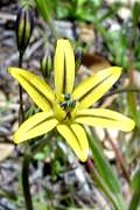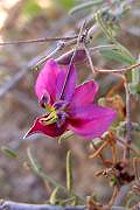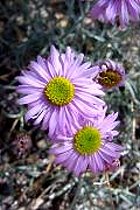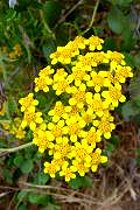- Si'bara: an anagram of Arabis. The genus Sibara was published by Edward Greene in 1896.
- Sibarop'sis: bearing a resemblance to genus Sibara. The genus Sibaropsis was published by Steve Boyd and Timothy S. Ross in 1997.
- Sibbald'ia/sibbald'ii: named for Sir Robert
Sibbald (1641-1722), "a Scottish physician and antiquary, who
was born in
 |
|
Edinburgh on the 15th of April 1641. Educated at Edinburgh,
Leiden and Paris, he took his doctor's degree at Angers in 1662, and
soon afterwards settled as a physician in Edinburgh. In 1667 with
Sir Andrew Balfour he started the botanical garden in Edinburgh, and
he took a leading part in establishing the Royal College of Physicians
of Edinburgh, of which he was elected president in 1684. In 1685 he
was appointed the first professor of medicine in the university. He
was also [granted knighthood and] appointed Geographer-Royal [and
Physician in Ordinary to His Majesty |
King Charles II] in 1682, and his numerous and miscellaneous writings deal effectively with historical
and antiquarian as well as botanical and medical subjects. Amongst
Sibbald's historical and antiquarian works may be mentioned A History
Ancient and Modern of the Sheriffdoms of Fife and Kinross (Edinburgh,
1710, and Cupar, 1803), An Account of the Scottish Atlas (folio,
Edinburgh, 1683), Scotia Illustrata (Edinburgh, 1684) and Description
of the Isles of Orkney and Shetland (folio, Edinburgh, 1711 and
1845). The Remains of Sir Robert Sibbald, containing his autobiography,
memoirs of the Royal College of Physicians, a portion of his literary
correspondence and account of his manuscripts, was published at Edinburgh
in 1833." (From the 1911
Encyclopedia online) "Sibbald's commission in 1682
was to produce not only a natural history of Scotland, but also a
geographical description that would combine historical data with the
results of contemporary survey. Sibbald's intentions, outlined in
his 1683 Account of the Scottish Atlas, or the Description of Scotland,
centered upon a two-volume work: Scotia Antiqua would embrace
the historical development of the Scottish nation, the customs of
the people and their antiquities, and Scotia Moderna would
describe the country's resources as a matter of contemporary chorography
or regional description, on a county-by-county basis. In the event,
this 'Atlas' was never completed. Only the natural history, Scotia
Illustrata, was ever published." (From the website of the National Library
of Scotland) This work included a section devoted to the
indigenous plants of Scotland, including some rare species, one of
which was subsequently called Sibbaldia, by Linnaeus, published in honor
of its discoverer in 1753. He died in August 1722. The genus Sibbaldia is called sibbaldia or mountain cinquefoil.
- sibir'ica/sibir'icum: of or from Siberia.
- sibthorpio'ides: resembling the genus Sibthorpia, which was
named for Humphrey Sibthorp (1713-1797), a professor of botany at
Oxford University where he only gave one lecture in thirty-seven years. After the death of Johann Jacob Dillenius (1684–1747), he became the Sherardian Professor of Botany from 1747 to 1783. He began the catalogue of the plants of the botanical garden of the university, Catalogus Plantarum Horti Botanici Oxoniensis. He was married twice and had two daughters and two sons. His youngest son was the botanist John Sibthorp (1758–1796), who continued the Catalogus Plantarum, and his oldest son, Humphrey, was a Tory MP for Lincoln.
- Si'da: an ancient name used by Theophrastus from the Greek sidē for "pomegranate or water lily." The genus Sida was published by Carl Linnaeus in 1753.
- Sidal'cea: a combination of two related genera
in the Mallow family, Sida and Alcea, which were also
two Greek names for mallow. The genus Sidalcea was published by Asa Gray in 1849.
- siderox'ylon: from the Greek sideros, "iron," and xylon, "wood." The only taxon in the California flora is the introduced Eucalyptus sideroxylon, called red ironbark.
- Sidothe'ca: from the Latin sidus, "star," and theke,
"case, box, container" referring to the numerous star-like involucres. The genus Sidotheca was published by James Reveal in 2004.
- Siegling'ia: named for Johann Blasius Siegling (1760-1835), a botanist and professor of botany, mathematics and philosophy at Erfurt, Germany, and an explorer of the local flora. He was born in Suhl and married Anna Regina Schroder. He worked as a scientist in Thuringia. The genus Sieglinia was published by Johann Jakob Bernhardi in 1800.
- sier'rae: sierra is Spanish for "mountain
range," so this is just a general word for "of the mountains."
(Thanks to Bob Allen and David Hollombe for their input.)
- sierren'sis: of the mountains in general or of the Sierras in particular. One taxon in California has this epithet, Erigeron petrophilus var. sierrensis.
- Sievers'ia: named for Johann August Carl Sievers (1762-1795), a German pharmacist and botanist. He came from Peine in Lower Saxony, and emigrated in 1785 as a twenty-two-year-old to St. Petersburg, Russia. In 1789 he was commissioned to research medicinal rhubarb in central Asia. Having been introduced to western Europe in the 6th century, this was one of the most sought-after and expensive plant drugs, utilized mainly as a very effective laxative, and had been typically imported from China. The Russian medical college was eager to develop its own collection of native plants and Sievers went on search expeditions from 1790 to 1795 from the Urals to Dauria, a region that lies between Lake Baikal and the upper reaches of the Amur River, and to Mongolia. He is credited by at least one source with being the first botanist to explore the Tarbagatai Mountains, a range located in the northwestern parts of Xinjiang, China and East Kazakhstan. He did not receive permission to enter China, and hence did not find the Chinese rhubarb. He did however collect extensively during this five-year mission, including wild apples in south-east Kazakhstan, Malus sieversii, which is the ancestor of the domesticated apple, and the first recorded example of Picea schrenkiana. The Prussian zoologist and botanist Peter Simon Pallas in St. Petersburg published his letters in his Neueste Nordische Beyträge in 1796 and a list of his collected plants in Nova Acta Academiae Scientiarum Imperialis Petropolitanae (1797). For some reason his name is sometimes given as Johann Erasmus Sievers. He died suddenly at the age of 33. The genus Sieversia was published by Carl Ludwig von Willdenow in 1811.
- sigmoid'eus: S-shaped, from the Greek letter sigma.
- signa'tum: well-marked, sealed, having been signed, from the Latin signo, "I mark, seal, sign." The Oxford English Dictionary's earliest evidence for the use of signatum is from 1666, in the writing of John Smith, physician.
- Sile'ne: probably named for Silenus, a woodland deity who was the usually intoxicated foster-father and companion/tutor of Bacchus
or Dionysus, the God of Wine, and was said to be covered with sticky foam, much like the glandular secretions
of many species of this genus. The root silenus in Latin apparently means "foam." Gledhill says this was Theophrastus' name for another catchfly, Viscaria.The genus Silene was published in 1753 by Carl Linnaeus who was fond of using mythological names.
- sili'qua: from the Latin siliqua, "a pod or husk."
- silvat'ica: of or from the woods, from the Latin sylva, "forest."
- silvico'la: inhabiting woods.
- Sil'ybum: from the Greek name for a thistle
that was used for food. The genus Silybum was published by Michel Adanson in 1763.
- sim'ilis: similar, alike, from Latin similis, meaning similar.
- Simmonds'ia: named for Thomas William Simmonds (1767-1804), an English botanist and physician who died exploring Trinidad. This information comes from Flora Cravoniensis: A Flora of the Vicinity of Settle in Craven, Yorkshire (1878) by John Windsor (1787-1868), and was referred to me by David Hollombe. He dedicated this book “to the memory of his old friends and fellow-botanists, William Kenyon of Settle, Thomas Williams Simmonds of Settle, John Carr of Stackhouse, and John Howson of Giggleswick." Simmonds was a native of Kent, was educated at Giggleswick School near Settle, and was a pupil of the surgeon William Sutcliffe. He was initiated in botany by William Kenyon, a nailmaker and knowledgeable botany enthusiast of Settle. He then studied comparative anatomy and other branches of natural history in London and Edinburgh. In 1803 he went out as a naturalist at the behest of Lord Seaforth, governor of Barbados, who had himself been elected in 1794 a fellow of the Royal Society for his contributions to botany and then a fellow of the Royal Society of Edinburgh and a fellow of the Linnaean Society, and was later to have a plant named for him, Seaforthia. Simmonds extended his researches from Barbados to the island of Trinidad, where he unfortunately succumbed to a fever and died the following year. The gemus Simmondsia was published in 1844 by Thomas Nuttall.
- simon'ii: named for Eugène Ernest Simon (1871-1967), a French botanist and amateur archeologist. He was born in Aulnay-de-Saintonge, France, and died at Tours. He studied Oahu herbarium material for Flora Hawaiiensis. He was a member of the the French Botanical Society beginning in 1919, and also a member of the Touraine Natural Sciences Society, the Biogeographic Society and the International Academy of Botanical Geography.
- simons'ii: named for British pharmacist and botanist Dr. Charles James Simons (1813-1894), a 'government apothecary' in India who collected plants in Assam, Khasia and the Mikir Hills. He was both born and died in India.
- sim'plex: simple, undivided, unbranched.
- simplicifo'lia/simplicifo'lius: from the Latin simplex for "simple." Stearn's Dictionary of Plant Names says "with
simple (entire or undivided) leaves."
- Simpsonan'thus/simpson'ii: named for Michael George Simpson (1953- ) who was born and raised in Pensacola,
 |
|
Florida, getting his BS degree at the University of Florida. During his undergraduate years, he changed his major from chemistry to botany after, in his words, “becoming enthralled with the diversity and complexity of plants." He subsequently obtained an MS degree in botany at the University of North Carolina Chapel Hill, followed by a PhD in botany at Duke University (1983). After a position at Albright College in Pennsylvania, he accepted a position at San Diego State University in 1986, where he is now professor emeritus. He continues as curator of the SDSU |
herbarium and is involved with the Consortium of California Herbaria. Aside from research articles, he has published three editions of a textbook, Plant Systematics, widely used in courses around the world. His research interests earlier in his career included plant embryology and palynology, as well as the then nascent field of phylogenetic systematics. His earlier work centered on Commelinid monocotyledons, especially the family Haemodoraceae, traveling to Australia and South Africa to obtain material. More recently, he has focused on the Boraginaceae, subtribe Amsinckiinae (the so-called “popcorn flowers”), continuing both taxonomic and molecular phylogenetic work in the group, especially the genus Cryptantha. He also has a strong interest and continues work on plants with an American amphitropical disjunction, common taxa or clades distributed in mostly temperate and desert regions of western North America and South America, not in the intervening tropical zone. He continues taxonomic work on plants of Chile and Argentina and is working on a revision of the South American Cryptantha. The genus Simpsonanthus was published in 2020 by C. Matt Guilliams, Kristen E. Hasenstab-Lehman and Bruce Baldwin. (Chenopodium simpsonii)
- simpson'ii: named for James Hervey Simpson (1813-1883). The following
is quoted from the entry on Simpson in the
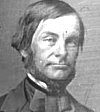 |
|
website Virtual
American Biographies: "Simpson, James Hervey, soldier, born
in New Jersey, 9 March, 1813; died in St. Paul, Minnesota, 2 March,
1883. He was graduated at the United States Military Academy in 1832,
and assigned to the artillery. During the Florida war he was aide
to General Abraham Eustis. He was made 1st Lieutenant in the Corps
of Topographical Engineers on 7 July, 1838, engaged in surveying the
northern lakes and the western plains, was promoted Captain on 3 March,
1853, served as chief topographical engineer with the Army in Utah,
and in 1859 |
explored a new route from Salt Lake City to the Pacific
coast, the reports of which he was busy in preparing till the beginning
of the civil war. He served as chief topographical engineer of the
Department of the Shenandoah, was promoted Major on 6 August, 1861,
was made Colonel of the 4th New Jersey Volunteers on 12 August, 1861,
and took part in the Peninsular Campaign, being engaged at West Point
and at Oaines's Mills, where he was taken prisoner. After his exchange
in August, 1862, he resigned his volunteer commission in order to
act as chief topographical engineer, and afterward as chief engineer
of the Department of the Ohio, where he was employed in making and
repairing railroads and erecting temporary fortifications. He was
promoted Lieutenant-Colonel of engineers on 1 June, 1863, had general
charge of fortifications in Kentucky from that time till the close
of the war, was brevetted Colonel and Brigadier-General in March,
1865, and was chief engineer of the Interior Department, having charge
of the inspection of the Union Pacific railroad, till 1867. He afterward
superintended defensive works at Key West, Mobile, and other places,
surveys of rivers and harbors, the improvement of navigation in the
Mississippi and other western rivers, and the construction of bridges
at Little Rock, Arkansas, St. Louis, Missouri, Clinton, Iowa, and
other places. General Simpson was the author of Shortest Route
to California across the Great Basin of Utah (Philadelphia, 1869),
and Essay on Coronado's March in Search of the Seven Cities of
Cibola (1869)." (Eriogonum microthecum var. simpsonii)
- simpson'ii: named for Joseph Herman Simpson (1841-1918), an amateur botanist and plant collector in Florida. He was born in Tiskilwa, Bureau County, Illinois, and studied the flora of that area before moving to Bradentown, Manatee County, Florida in 1882. He collected plants in southern Florida for the United States National Herbarium, and collected the type specimen of Sambucus simpsonii in 1910 in Manatee County, which is where he died. He married Ellen Holden Fenno in Bureau County on the 5th of March, 1865, but was divorced by 1880. (Sambucus simpsonii, Vitis simpsonii)
- Sims'ia: named for John Sims (1749-1831), an English physician and botanist born in Canterbury, Kent and educated
 |
|
at the Quaker school in Burford, Oxfordshire. He then studied medicine at Edinburgh University, obtaining a PhD in 1774. His father was also a physician. He moved to London in 1766 and worked as a physician at the Surrey Dispensary, purchasing an obstetric practice in 1779. He was admitted to the Royal College of Physicians the same year. In 1780 he was appointed physician and man midwife to the Charity for Delivering Poor Married Women at their own Houses. In 1817 he was called to the ill-fated childbirth of Princess Charlotte at which mother and baby died. He became the |
first editor of the well-known Curtis's Botanical Magazine and remained there until 1826. He also edited Annals of Botany with Charles Konig. He was a founding member of the Linnean Society, and in 1814 was elected a fellow of the Royal Society. His herbarium was purchased by George Bentham and passed to the Royal Botanic Gardens, Kew. The genus Simsia in the Proteaceae was published by Robert Brown in 1810 but that name was determined to be illegitimate because Christiaan Hendrik Persoon had already used the name for a species in the Asteraceae in 1807.
- sim'ulans: resembling.
- simula'ta: from the Latin simulo, "to make like,"
thus "made to resemble, resembling."
- Sinap'is: a Latin name, also spelled sinapi or sinape,
for the mustard plant, from the flavor of the seeds. The genus Sinapis was published by Carl Linnaeus in 1753.
- sinclair'i: named for Andrew Sinclair (1794-1861), a naval surgeon, naturalist, and New Zealand colonial secretary
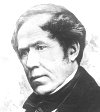 |
|
born in Paisley, Renfrewshire, Scotland. His father was a weaver, and he studied medicine and surgery at Glasgow University College from 1814 to 1816 at L'Hôpital de la Charité in Paris, and at the University of Edinburgh where he graduated as doctor of medicine and qualified as a licentiate in 1818. It’s unclear what he did between then and 1822 when he joined the Royal Navy as an assistant surgeon. From 1823 to 1833 he served on HMS Owen Glendower at the Cape of Good Hope and in the Mediterranean, having become a full surgeon in 1829. Wikipedia says: “Much of |
his spare time was taken up with collecting botanical and zoological samples, many of which he sent to the British Museum. He took further lectures in medicine and in 1835 joined HMS Sulphur on a surveying expedition to the South American coast under the command of Captain Frederick William Beechey, and afterwards of Sir Edward Belcher. Sinclair collected plants in California, Mexico, Central America and Brazil, which he continued to send to the British Museum or the Kew Gardens. During this period, he gained a reputation as an important collector. He returned to England in 1839 because of declining health.” The Encyclopedia of New Zealand adds: “After recovering his health he began a brief period as a surgeon on convict ships to Australia. On one voyage in 1841 he visited the Bay of Islands, New Zealand, arriving on the Favorite on 24 October. There he joined the missionary William Colenso and Joseph Dalton Hooker, assistant surgeon on James Clark Ross's Antarctic expedition which was in New Zealand at the time, on several local botanical expeditions. He subsequently presented to the British Museum a collection of shells and animals which included the shellfish pipi, crabs, spiders, dragonflies, cicadas, butterflies, corals and sponges. He returned to Scotland the following year. In September 1843 Sinclair arrived in Tasmania as surgeon superintendent on the convict ship Asiatic. After signing off he intended to return to England. However in Sydney he met Robert FitzRoy, the governor elect of New Zealand. The two struck an immediate rapport, and FitzRoy offered Sinclair a free passage to Auckland. They arrived there on 23 December 1843. On 6 January 1844, after much persuasion from FitzRoy, Sinclair reluctantly accepted the appointment of colonial secretary, and was also made a member of the Legislative Council on 8 January.” He remained in that capacity until 1856 and during this time he also devoted himself to business transactions and a variety of cultural pursuits. He is credited with training a staff which formed the basis of an effective civil service for New Zealand, and he was regarded as honest, upright, scrupulous and laborious. His political career has been described as unremarkable. He was a founder of the Auckland Museum in 1852. After his retirement he visited Scotland and Europe, where he discussed a wide range of scientific matters with Charles Darwin, Thomas Huxley and Richard Owen. He became a fellow of the Linnean Society in 1857 and returned to New Zealand in 1859 to collect on the South Island and on Stewart Island material for a supplement to Hooker's Handbook of the New Zealand flora. He made arrangements with Sir Julius von Haast to explore Mount Cook, but was drowned in 1861 trying to cross the flooded Rangitata River. His zoological specimens, chiefly sponges and zoophytes, were mostly presented to the British Museum, and his plants to Sir William Hooker.
- sinen'sis: of or from China.
- sinis'tra: I've found two meanings for this specific epithet; (1)
"elder, senior," and (2) "left, on the left hand"
and I have no idea how either would be applied. Another source says 'awkward.' Sinistra is apparently also the name of a star in the constellation Ophiuchus.
- sinua'ta/sinua'tum: having
sinuous or wavy margins, from Latin sinuosa, "sinuous, winding."
- sinuo'sa: same as sinuata.
- siphocampylo'ides: like Siphocampylus,
from the Greek siphon, "tube," and kampylos,
"curve," with reference to the curved corolla.
- sisymbriifo'lium: with leaves like genus Sisymbrium.
- siskiyouen'se/siskiyouen'sis: of or from Siskiyou County or the Siskiyou
Mountains.
- Sisym'brium: a Greek name for some plant
of the mustard family. The genus Sisymbrium was published by Carl Linnaeus in 1753.
- Sisyrinch'ium: FNA says "an old Greek name probably
first applied to some other plant, from Greek sys, "pig," and rynchos, "snout," alluding to swine grubbing the roots for food," and authors as early as 1666 provide this derivation. However Wikipedia presents an alternative derivation in saying "Sisyrinchíon is the Greek word, recorded by Pliny and Theophrastus, for the Barbary nut iris (Iris or Moraea sisyrinchium), and refers to the way the corm tunics resemble a shaggy goat's-hair coat, sisýra. As Goldblatt and Manning explain, "the reason for applying the name to a genus of New World Iridaceae was apparently arbitrary." The FNA derivation seems to be the one most commonly accepted. The genus Sisyrinchium was published by Carl Linnaeus in 1753.
- sitchen'sis: of or from Sitka in southeast Alaska.
- sitgreaves'ii: named for Lorenzo Sitgreaves (1810-1886), a US Army officer from Pennsylvania who led the 1851 Sitgreaves Expedition down the Zuñi and Colorado rivers. He was born in Easton, Pennsylvania, and was a cadet at the United States Military Academy, West Point, from 1827 to 1832, and then served at a variety of garrisons in Virginia until he resigned his commission as a 2nd Lieutenant in 1836. For the next two years he was a civil engineer, and then was again appointed as a 2nd Lieutenant in the Corps of Topographical Engineers. He worked on construction of roads in Wisconsin and then as an assistant topographical engineer in a survey of the US border in Texas and near New Orleans. Over the next several years he worked in Washington, D.C., then was involved in the improvement of the Hudson River, a survey of the harbor of Portsmouth, New Hampshire, and a survey of the reefs in Florida. He did survey and mapping work and then fought in the Mexican War, being promoted to Brevet Captain. After the war he was put in charge of the Boundary Survey of the Creek Indian Territory in 1849 and then again was assistant in the Topographical Bureau, at Washington, D.C., in 1850. Wikipedia says: “In 1851, Brevet Captain Sitgreaves led an expedition down the Zuni River and westward to the Colorado River, with John G. Parke his second in command and Antoine Leroux as his guide. This expedition was the first systematic survey of the area of the upper region of New Mexico Territory between Zuñi Pueblo and the Colorado River, in search of a route to California.The trip took from September 4 to November 30, 1851, between Zuñi and the Yuma Crossing. Following the expedition, he spent most of 1852 preparing a report on the expedition, which was published in 1853. Soon afterward, on March 3, 1853, he was promoted to Captain, Corps of Topographical Engineers, after 14 years of continuous service in the Corps.” During the mid- to late 1850s he served as lighthouse inspector in Detroit and then as lighthouse engineer in Baltimore. When the Civil War began, he was recalled and served in various positions such as mustering officer at Albany, New York, and superintendent of the Volunteer Recruiting Service and disbursing officer at Madison, Wisconsin, being promoted first to Major and then to Lieutenant-Colonel. After the war he worked on harbor improvements on Lake Michigan and retired from active service in 1866. He died at the age of 78 at Washington, DC.
- Si'um: derived from the old Greek name sion which was applied
to a marsh herb of the Apiaceae. The genus Sium was published by Carl Linnaeus in 1753.
- skottsberg'ii: named for Dr. Carl Johan Fredrik Skottsberg (1880-1963), a Swedish botanist and Antarctic explorer
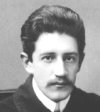 |
|
born in Karlshamn. His father was a schoolmaster. He was educated locally then studied sciences at Uppsala University from 1898, specialising in botany, and received his doctorate there in 1907. From 1901 to 1903 Skottsberg served as official botanist to the Swedish Antarctic Expedition of 1901 to 1903 on the ship Antarctic. On his return to Sweden, Skottsberg published (1905) the first comprehensive phytogeographic study of the flora of southern Patagonia and Tierra del Fuego. Later he led the Swedish Magellanic Expedition to Patagonia, 1907 to 1909, which included |
botanical explorations in the Falklands, Tierra del Fuego, Chile and South Georgia. Carl Skottsberg is believed to have been the last to have seen the Chile sandalwood tree (Santalum fernandezianum) alive when he visited the Juan Fernández Islands in 1908. It was cut to extinction for its aromatic wood. He was conservator at the Uppsala University botanical museum from 1909 to 1914, and led the work on the new botanical garden in Gothenburg from 1915, then was appointed professor and director of the garden there in 1919, remaining in that position for 29 years. The first of his trips to Hawaii was in 1922. Few botanical observations had ever been made in many of these areas and his reputation as a taxonomist was secured. He thereby established a lifelong interest in geographical distribution, especially in the Pacific region. In 1916-1917 he again led a Swedish expedition to the Juan Fernández Islands, Easter Island and Chile. He returned to the Hawaiian Islands again in 1926, 1938 and 1948, to investigate the differences of the vegetation there and in the Juan Fernández Islands. JSTOR adds the following: “Skottsberg's interests in many different plant families appear diverse and possibly unconnected, but his ultimate aim was to make phytogeographic links. He elaborated on Sir Joseph Hooker's idea that the continents were not separated by sea in the past, using his findings from his Antarctic and sub-Antarctic explorations. For example, fossil plant remains (Jurassic and Oligecene) he discovered in Graham's Land led him to suggest that a warm-climate flora once occupied the area now glaciated, plants that later in the Tertiary period migrated northwards and became differentiated. He was also something of a conservationist, concerned over the ways human intervention threatened endemic species. In 1935, Juan Fernández was declared a National Park thanks to Skottsberg's efforts, though he was pessimistic about solutions to the destructive tendencies of civilization. He stood as secretary of the International Commission for Preservation of Wild Life in the Pacific for 20 years from 1929. In 1949 Skottsberg was elected president of the Royal Swedish Academy and in 1950 president of the Seventh International Botanical Congress. In the same year he was elected a foreign member of the Royal Society, and came to be honorary member of countless scientific societies in Europe, the Americas, Japan and New Zealand over the course of his career. He was awarded the Linnean Society of London's Darwin-Wallace Medal in 1958 and the Linnean Medal in 1959. Other posts he held included secretary of the Royal Society of Science and Letters of Gothenburg (1924-1937) and chair of the Botanical Society of Gothenburg (which he founded in 1919). His writings mainly concerned the flora and taxonomy of the places he explored, and included The Wilds of Patagonia (1911), three volumes of The Natural History of Juan Fernández and Easter Island (edited from 1920-1956) and 'Remarks on the Plant Geography of the Southern Cold Temperate Zone' in the Proceedings of the Royal Society of London (1960). Numerous plants are named in his honor, including the genera Skottsbergia (Ditrichaceae), Skottsbergiella (Lamiaceae), and Skottsbergiliana (Cucurbitaceae). Skottsberg married in 1909, and his wife, Inga (née Reuter) joined him in collecting on several trips and bore him three children.”
- slavin'ii: named for self-taught botanist Bernard Henry Slavin (1873-1960), nationally known for his great knowledge
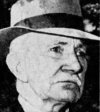 |
|
of horticulture and botany. He joined the Rochester Parks Bureau as a laborer in 1890, then went to Highland Park as foreman. In 1903 he was transferred to Seneca Park also as foreman. He was appointed as an assistant superintendent in 1910 and superintendent in 1926. He was largely responsible for the plantings in Durand-Eastman Park, and he retired in 1942. After his retirement, as horticultural advisor to Rochester area garden clubs, he was awarded a medal from the Federated Garden Clubs of New York State for “fine horticultural achievements, widespread public education |
and appreciation of plant material.” In November, 1959, he was cited by the Western New York Arborists’ Association for “pioneering in the selection, propagation and use of better-adaped species of trees and shrubs for city streets.” His brother was Parks Director Patrick J. Slavin and his son was the botanist Arthur Daniel Slavin. (Photo credit: Obituary Rochester Democrat and Chronicle 30 Mar. 1960)
- slwoo'koorum: the ending -orum usually is either a reference to the habitat of the species such as desertorum, pinetorum, dumetorum, scopulorum etc., or as a commemorative epithet honoring a group of two or more persons where both sexes are included. The latter is the case here and refers to the Yup'ik name Slwooko. The Yup'ik people are related to the Inuit, generally grouped under the term Eskimo, and are indigenous to western, southwestern and southcentral Alaska and the Russian Far East. Thanks to David Hollombe for providing the following: "The new species [Juncus slwookoorum] is named after the Slwooko family of Gambell, Saint Lawrence Island. Several members of this family contributed greatly to the success of my field work on the island. Boxer Bay, the type locality for J. Slwookoorum, is the ancestral hunting and trapping ground of the Slwookos." He adds that other researchers have specifically thanked Vernon Qaqsungiq Slwooko (1917-2005), and his wife Beda Avaluk J. (Tungiyan) Slwooko (1918-2009), for their hospitality and it's likely that they were the individuals referred to above as having contributed to field work on Saint Lawrence Island. The person referred to above as having done the field work and is the author of the species is botanist Steven Burr Young (1938- ).
- small'ii/smallia'na/smallia'num: named for John Kunkel Small (1869-1938), a botanist at the
New York Botanical
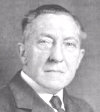 |
|
Gardens who had described a plant collected by
the Hellers (Amos Arthur and Emily Gertrude) in Idaho in 1896 as Eriogonum croceum. In 1902
A.A. Heller found a similar plant in Lake County, CA, and labeled
his specimens as being the same. When he realized the new plants were
different he named them E. smallianum, with no further explanation,
but apparently after James K. Small (apparently a mistake in the name) (info from David Hollombe). Small
was the author of Flora of the Southeastern States (1903) and Manual for the Southeastern Flora (1933). The following is |
quoted from a website of the New York Botanical Garden: "John Kunkel Small was a taxonomist and botanical explorer, specializing in the southeastern United States,
especially Florida. He was the first curator of museums at The New
York Botanical Garden, a post in which he served from 1898 until 1906.
In 1906, as the garden's staff expanded, Small was named head curator.
He held this position until 1934. As such, he played an active part
in building the institution and establishing the herbarium collections and the protocols for their exhibition.
He personally collected over 60,000 herbarium specimens of flowering
plants, ferns, mosses, hepatics, and fungi for the garden's collections.
In 1934 he was named chief research associate and curator. Small was born on January 31, 1869 in Harrisburg,
Pennsylvania. He attended Franklin & Marshall College, graduating
with a degree in botany in 1892. His first explorations of the southeastern
flora - the mountains of western North Carolina - occurred during
those years. His account was accepted by the Torrey Botanical Club
and published in the Memoirs. This brought him to the attention of
N.L. Britton, who offered him a fellowship to pursue graduate studies
at Columbia. His dissertation Monograph of the North American Species
of Polygonum (1895) was the first volume of the Memoirs of
the Department of Botany of Columbia College. After graduation,
he stayed on as curator of the herbarium at Columbia, establishing
it as the first herbarium arranged according to the Engler and Prantl
sequence. When Columbia's herbarium was transferred to The New York
Botanical Garden in 1898, Small followed it as curator. Small was the first botanist to explore Florida
since Alvan Wentworth Chapman and many of the areas he documented had never been
examined. His doctoral dissertation, published as Flora of the
Southeastern United States in 1903, and revised 1913 and 1933,
remains the best floristic reference for much of the south. His first
trip to Florida was in 1901 when Miami had some 2,000 residents. The
Florida hammock in which he was particularly interested had disappeared
to such an extent by 1929 that he published From Eden to Sahara:
Florida's Tragedy, sparking a movement for conservation of the
wetlands that eventually resulted in the formation of Everglades
National Park. Small followed the taxonomic philosophy of Britton.
He contributed descriptions of several families for the first edition
of Britton and Brown's An Illustrated Flora of the northern United
States, Canada and the British possessions... 1896-1898. Today,
some scientists consider his species classifications too narrow, yet
other of his observations have been reconfirmed. Index Kewensis cites
Small as the author of 2,057 genera, species, and binomials. Dr. Small discovered the Louisiana wild iris
after glimpsing a bed growing in a swamp as the train he was on passed
by. He returned using a hand-car, the railroad had put at his disposal.
He harvested the irises and with E.J. Alexander classified nearly
ninety distinct species, documented in Addisonia. Small distributed
6,500 packets of seeds and several thousand plants throughout the
world. Because the swamps in which they were growing were being drained,
Dr. Small is credited with saving the Louisiana wild iris from extinction.
Dr. Small lived at a time before foundation or governmental research
support. His excursions to Florida were under the patronage of Charles
Deering and later, Arthur C. James. These were lively events, conducted
by boat and car. Dr. Small often brought along his wife, Elizabeth,
and four children. On at least one occasion (1918) the garden sent
along the artist Mary Eaton, who produced twenty-eight watercolors
of rare flowering plants. Because he would have been compelled to
pay for publication from his own pocket, only a small portion of Small's
work was ever published. Much of his material remains in the form
of bound typescripts. Of the work that has been published, there have
been reprints as recently as 1987. His bibliography consists of 450
items, mostly articles. In his later years, Small concentrated on
ferns, cacti and palms. Between 1927 and 1931, he worked with Thomas
A. Edison on his search for rubber-producing plants. This included
fieldwork in Florida and hybridization in the laboratories of the
New York Botanical Garden. John Kunkel Small died at his home on E.
207th Street in Manhattan on January 20, 1938."
- Smelows'kia: named for Timofei Andreevich (Andrejewitsch) Smielowski (Smelowsky) (1769-1815),
a Russian pharmacologist, university professor and botanist at St. Petersburg, and author of Hortus
petropolitanus. The following information was translated from German Wikipedia: “Smelovsky came from the family of a priest near Kiev, and graduated from the Kharkov Spiritual Seminary together with his brother Ivan. In 1788 Smelowski went to St. Petersburg and began studying at the St. Petersburg General Hospital School. In 1789 he was appointed junior doctor and in 1790 he was seconded to the Smolensk Dragoon Regiment. In 1793 he was sent back to the hospital school for further studies. After graduating in 1795, he stayed there for further studies. In 1796, at the suggestion of professor of chemistry Vasily Mikhailovich Severgin of the St. Petersburg Medical-Surgical School, Smelovsky became adjunct professor of chemistry and botany at this school, which became the Medical-Surgical Academy in 1798. In January, 1799 he was promoted to staff surgeon for the proposed quarantine measures. As part of the confirmation of the professors and adjunct professors in the new academy in their positions in 1799, Smelowski became adjunct professor of botany and chemistry and often represented Severgin. After the death of Professor Karl Johann Christian Ringebroig, Smelowski took over his office. and was elected associate professor at the chair of botany, chemistry and materia medica. In addition to lectures on medicine, he gave chemistry lectures for Severgin and botany lectures for Grigory Fyodorovich Sobolevsky. It was not until 1803 that Smelowski received a chemical laboratory assistant to support him. He represented Severgin until the end of 1804, when the chemistry chair was transferred to Alexander Nicolaus Scherer. After Johann Peter Frank was appointed rector of the academy in 1806, the first clinics were opened. Smelowski was commissioned to set up a scientifically structured pharmacy and to create a list of the medications needed for the clinics. When the academy was reorganized in 1808, Smelowski became professor of pharmacy. His assistant was Alexander Petrovich Nelyubin. In August, 1809 he was sent to the Tver Governorate to examine the mineral waters there, and after his return he prepared a detailed report. In September, 1809 he was awarded the title of Doctor of Medicine and Surgery honoris causa by the Academy Conference. In 1810 he discussed the problem of replacing foreign medicines with Russian products in the Medical Council together with Johann-Peter Friedrich Busch and Semyon Fyodorovich Gaevsky. In the same year he took over the botany lectures again. In 1811 he created a catalog of the plants in the botanical garden assigned to him. In October 1814 he received the title of academic. Smelowski had no family or relatives. After his sudden death, his property went to the academy. The botanical garden was sold due to a lack of financial resources for maintenance. Smelowski had a major influence on the development of botany and botanical terminology in Russia through his translation of Linnaeus's Philosophia botanica (1800) and his critical consideration of Linnaeus's system for the plant kingdom (1808). The genus Smelowskia was published by Carl Anton von Meyer in 1830.
- Smilaci'na: Stearn's Dictionary of Plant
Names says a diminutive of Smilax, a genus of greenhouse
plants which it resembles, literally "a little Smilax,"
and Umberto Quattrocchi adds, "from the Greek smilakinos,
"of the smilax." The genus Smilacina was published by René Louiche Desfontaines in 1807.
- Smithias'trum: named for James Payne Smith, Jr., a professor emeritus in biology at Humboldt State University and author of Field Guide to Grasses of California. The genus Smithiastrum was published in 2020 by Nancy Ruth Morin.
- smith'ii: named for Christen Smith (1785-1816), a Norwegian physician, economist, naturalist, and botanist. He was
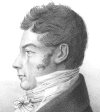 |
|
born at Skoger in Drammen, Norway, and studied medicine and botany at the University of Copenhagen under Professor Martin Vahl. In 1808, Smith graduated and started to practice medicine in Norway. Together with Jens Wilken Hornemann, and with Joakim Frederik Schouw and Morten Wormskjold for at least part of the trip, he traveled through large parts of Norway and carried out botanical investigations, collecting plants to be included in the plate work Flora Danica. In 1814 he was appointed professor of botany and land economy at the Royal Frederick University |
of Christiania (Oslo). In that same year he inherited money that allowed him to begin his travels, and he never really took up the position. Instead, as Wikipedia relates: “He embarked upon travels abroad to establish contacts and keep abreast of the development of botanical gardens in Europe. His first journey took him to Scotland and from there to London, where he met the Prussian geologist Leopold von Buch. Buch planned to visit the volcanic Canary Islands and Madeira, and Smith eagerly seized the opportunity to participate in an expedition with the experienced scientist. In 1815, the two embarked on the trip. They returned to Portsmouth on December 8, the same year, Smith bringing 600 species of plants, of which about 50 were new to science. The best known of Smith's new species is probably Pinus canariensis, the Canary Island Pine. Having learned geology from Buch in addition to discovering new plant species, Smith was approached by the Royal Society of London and asked to participate in a scientific expedition under Captain James Hingston Tuckey to determine whether the Congo River had any connection to the Niger basins of western and central Africa. Smith was to function as the expedition's botanist and geologist. He had as assistant David Lockhart, who was to survive the journey. The Congo expedition began in February 1816 and went badly from the start. The original plan was to sail up the river using the expedition ship HMS Congo, which had originally been constructed as a steamboat, a technology that was still in its infancy. While the ship was eventually rigged for conventional sails, the heavy construction made it sit deep in the water. The accompanying lighter vessel Dorothy was also used but was stopped by rapids 160 km inland. The expedition continued on foot up along the Congo through mosquito-infested swamps. The expedition advanced 450 kilometres up the river, but lack of food, hostile natives and ravaging tropical fevers forced the expedition to turn back without having found the sought connection. On the way downriver, Smith caught a tropical fever (probably yellow fever) and died, less than a month shy of his 31st birthday. In all, 18 of the 56 members of the expedition perished, including all the scientists and the captain, who died after returning to the ship. The ill-fated expedition was part of the inspiration for Joseph Conrad's Heart of Darkness, written almost a century later.” His diary and plant specimens, a collection consisting of about 620 species of which 250 were new to science, were shipped to London, and many were published by other botanists. He also left behind several texts that were later published by his friend Martin Richard Flor. (Hygrohypnum smithii)
- smith'ii: named for Clifton F. Smith (1920-2000), Santa Barbara County’s most renowned field botanist for over 50
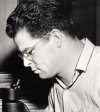 |
|
years, senior botanist at the Santa Barbara Botanic Garden (in whose honor the herbarium there is named) and author of A Flora of the Santa Barbara Region, California. He was born in Santa Barbara and lived there his entire life. He joined the staff of the Santa Barbara Museum of Natural History as a part time assistant in 1947 and made his first collecting trip to Santa Rosa Island two years later, followed by visits to Santa Cruz, Anacapa and San Miguel islands. He is member #28 of the exclusive All Eight Club of people who have visited all eight of the Channel islands. He |
collected and catalogued over 10,000 plant specimens. Galium cliftonsmithii was published by Lauramay Tinsley Dempster. (Eriodictyon traskiae smithii) (Photo credit: Islapedia)
- smith'ii: named for James Edward Smith (1759-1828). The following is
quoted from Wikipedia: "Sir James Edward
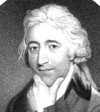 |
|
Smith was an English
botanist and founder of the Linnean Society. Smith was born in Norwich
in 1759, the son of a wealthy wool merchant. He displayed a precocious
interest in the natural world. During the early 1780s he enrolled
in the medical course at the University of Edinburgh where he studied
chemistry under Professor Joseph Black and natural history under Professor
John Walker. He then moved to London in 1783 to continue his studies.
Smith was a friend of Sir Joseph Banks who was offered the entire
collection of books, manuscripts and specimens of the Swedish natural |
historian and botanist Carl Linnaeus, following the death of his
son Carl Linnaeus the Younger. Banks declined the purchase but
Smith bought the collection for the bargain price of £1,000.
The collection arrived in London in 1784 and in 1786 Smith was elected
fellow of the Royal Society. Between 1786 and 1788 Smith traveled
the Grand Tour through the Netherlands, France, Italy and Switzerland
visiting botanists, picture galleries and herbaria. He founded the
Linnean Society of London in 1788 becoming its first president, a
post he held until his death. He returned to live in Norwich in 1796
bringing with him the entire Linnean Collection. His library and botanical
collections acquired European fame and were visited by numerous entomologists
and botanists throughout the continent. Smith spent the remaining
thirty years of his life writing books and articles on botany. His
books included Flora Britannica and The English Flora (4 volumes, 1824–1828). He contributed 3,348 botanical articles
to Rees's Cyclopaedia between 1808 and 1819, following the death of
Rev. William Wood, who had started the work. In 1797 Smith published The Natural History of the Rarer Lepidopterous Insects of Georgia,
the earliest book on American insects. It included the illustrations
and notes of John Abbot, with descriptions of new species by Smith
based on Abbot's drawings." (Disporum smithii, Erythronium smithii, Lepidium smithii)
- smith'ii: named for Jared Gage Smith (1866-1957), a botanist and agrostologist
for the United States Department of Agriculture. He was an assistant
agriculturist with the Nebraska Agricultural Experimental Station
from 1888 to 1890, traveled in Europe, Australia and Mexico from
1890 to 1892, and became a botany assistant at the Missouri Botanical
Garden from 1892 remaining there until 1895. From 1895 to 1899 he
was assistant agrostologist with the USDA. Later he was special agent
in charge at the Hawaii Experimental Station, worked with the Kona
Tobacco Co., and was an assistant professor of agronomy at the College
of Hawaii. For some years he was a tobacco planter and authored many
publications. (Pascopyrum smithii)
- sobolif'era: sprout-bearing, having creeping rooting stems, from the Latin sobol, "offshoot, sprout" and ferre, "to bear, bring forth, produce."
- socia'lis: growing in colonies, from Latin socius, “associated, allied, companion" and -ālis, Latin adjectival suffix meaning belonging to or pertaining
to something.
- so'da: Gledhill says alkaline, medieval Latin from Arabic suwwad, the calcined ash of Salsola kali. David Hollombe suggests that this may be from the same root
as Suaeda.
- solan'deri: named for Daniel Carl Solander (1736-1782). The following
is quoted from a website called Plant
Ex-
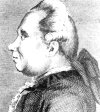 |
|
plorers: "Daniel Solander was one of Linnaeus' greatest
students and one of Joseph Banks best friends. Solander was born at
Piteå in Sweden, son of a Lutheran rector. In 1750 he went to
Uppsala University to study law, but became so interested in the work
of Linnaeus that he redirected his focus to the study of botany and
natural science. Solander assisted Linnaeus with classifying and indexing
several major collections in Sweden, and published an abridged version
of Linnaeus' work on general botany. He also participated in botanizing
in Lapland and Norway. In 1759 Linnaeus |
asked Solander to travel to
England to promote his new system of classification, and by all accounts
Solander was a hit with English society. In 1763 he was given an appointment
at the British museum, where he rearranged the natural history collection.
The following year he was elected to the Royal Society. Solander developed
a long-lasting friendship with Joseph Banks, who asked him to join
his team of botanical explorers on the Endeavour in 1768. Between
the two botanists, they collected well over 1,000 species of plants
new to science. When Banks pulled out of Cook's second expedition,
Solander's loyalty to Banks prevented him from joining the crew of
the Resolution. Instead, he joined Banks on an expedition to
Iceland, the Faeroes and the Orkney Islands. Soon after his return,
Solander was promoted to the post of keeper at the British Museum,
where he continued to increase the collections while conducting tours
for visitors. He also acted as Banks' librarian at Kew, and was responsible
for naming many of the new plant specimens sent to the Royal Botanic
Gardens."
- Solano'a: named for Francisco Solano (c.1799-1850), aka Sem-Yeto and Chief Solano, famous leader of the Suisunes, a people of the Suisun Bay region of California near San Francisco. When he was between 10 and 12 years old, with a native name of Sina, a Spanish army officer in the Viceroyalty of New Spain named Gabriel Moraga conducted a raid against the Suisun people and killed many of them. Sem-Yeto was either captured and taken to the San Francisco Mission or else he was taken there by surviving members of his tribe who did not want to fight anymore. He grew to adulthood at the Mission and learned Spanish there, becoming in the 1820s the leader of his people and being called Sem-Yeto, an epithet meaning "brave or fierce hand." He moved to the present-day town of Sonoma, California, in 1823, to help build the Mission San Francisco de Solano with many of the Suisunes tribe who had grown up at the San Francisco Mission, and would now be closer to their homeland. In 1835, however, the Mexican government began to close down and secularize the missions, dispersing the land and properties. General Mariano Guadalupe Vallejo was sent to become the comandante of the new pueblo project, to administer the secularization of the mission, and to keep military control in the region. Sem-Yeto and the Suisunes became allies of Vallejo, believing that an alliance with the Mexicans would help them against enemy tribes. Sem-Yeto became both a military leader and an ambassador of peace to other tribes, concluding a peace treaty in 1836. When the smallpox epidemic of 1837 decimated the native American population of the Sonoma-Marin region, Sem-Yeto was one of the few natives to be vaccinated and thus survived. Due to his friendship with and support of General Vallejo, Sem-Yeto was one of only two natives to receive a land grant rancho from the Mexican government, but was unable to retain it for his people after his death. The Mexicans lost control in 1846 when California became part of the United States. General Vallejo was taken prisoner and Sem-Yeto fled north as far as Oregon, Washington and possibly Alaska, returning to California in 1850 and dying soon thereafter of pneumonia. Solano County is named directly after Chief (Sem-Yeto) Solano.The genus Solanoa was published by Edward Greene in 1890.
- solanoa'na: uncertain but probably has some reference either to genus Solanum or to Solano County. The California taxon Asclepias solanoana appears to inhabit that area and goes by the name of serpentine milkweed.
- Sola'num: Latin for "quieting," in
reference to the narcotic properties of some species. Wikipedia says "The generic name was first used by Pliny the Elder for a plant also known as strychnos, most likely S. nigrum. Its derivation is uncertain, possibly stemming from the Latin word sol, meaning "sun." referring to its status as a plant of the sun." This doesn't seem to fit with its common name of nightshade. Jaeger's Source-book lists the Latin root solor, "to comfort, to sooth," and specifically lists the plant solanum's name as stemming from this derivation. The genus Solanum was published by Carl Linnaeus in 1753.
- Soldanel'la/soldanel'la: an Italian diminutive
of soldo, "coin," thus "a small coin,"
referring to the round leaves of some of the plants of this genus,
a characteristic which also applies to the beach morning glory. The genus Soldanella was published by Carl Linnaeus in 1753.
- Soleiro'lia/soleirol'ii: this is one about which there is some uncertainty. The common thinking is that the name honors
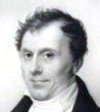 |
|
plant collector Joseph-Francois Soleirol (1781-1863) who
according to the JSTOR database collected between 1825 and 1829. Both Stearn's Dictionary of Plant Names, the Jepson Manual, and the CRC World Dictionary of Plant Names provide this information. However, David Hollombe's researches seem to indicate that Joseph-Francois Soleirol was not on Corsica and that it was his younger brother Henri Augustin Soleirol (1792-1860) who was stationed there and made vast collections of plants. Joseph-Francois Soleirol was a French Army engineering officer and |
amateur botanist. He was born in Verdun, studied at the École Polytechnique and then set out on a military career attaining the rank of Captain. He was an instructor at the School of Artillery and Engineering in Metz. In 1841 he became a member of the Académie Royale de Metz. He was a founding member and secretary of the Horticultural Society of Moselle and collected near Metz with Jean Joseph Jacques Holandre and Dominique Henry Louis Fournel. In 1843 he was the co-founder of the Société d'horticulture in Metz. He also had a passion for music, and served as director of the Société Philharmonique de Metz. His brother Henri-Augustin Soleirol (1792-1860), was a chief battalion engineer and biographer of Molière. He assembled a "Galerie théatrâle", consisting of 755 prints and 641 drawings and miniatures of drawings and prints, sold in Paris. Some of these, including several "pastels du temps," were reproduced in engravings by Frédéric Hillemacher in de Manne 1861. A very recent article in Candollea 74(2), 209-216, (7 October 2019) entitled "Les frères Soleirol, histoire séculaire d'une confusion autour d'un collecteur en Corse," confirms what David Hollombe has told me. "Our investigation shows that this botanist is in fact Henri-Augustin (1792–1860), the younger brother of Joseph-François. That conclusion is drawn on the analysis of his herbarium specimens, botanical literature, correspondence and biographical accounts. The Brothers Soleirol have followed a similar career in the French Army and had the same interests for art and botany. These similar ways of life have subsequently caused the confusion of their surnames. Our research shows that Henry-Augustin was the only one who collected plants in Corsica between 1820 and 1823 and visited about sixty localities from Cap Corse to Bonifacio through the large mountain ranges. As an important plant collector for Corsica, Soleirol has collected more than 5,000 specimens that he has distributed or exchanged with other botanists. This paper highlights the activity of an amateur botanist at the beginning of the 19th century. It honors Henry Augustin for his work after more than one century of confusion with his brother." He was born in Verdun and died in Paris. It's good to be able to clear up information that has been confused for such a long time. The genus Soleirolia was published by Charles Gaudichaud-Beaupré in 1830.
- soleiro'lii: see Soleirolia above.
- Solida'go: from the Latin solido, meaning
"to make whole or heal" and a reference to the supposed,
medicinal qualities of these plants. The genus Solidago was published by Carl Linnaeus in 1753.
- solier'i: named for the Frenchman Antoine Joseph Jean Solier (1792-1851),
a botanist, entomologist and soldier, also specialist in alga. He studied
at the Paris Ecole Polytechnique, was in the Napoleonic army as Lieutenant
with the engineers 1813-1815, Captain in the French Army at Marseilles
1815-1823 and Montpelier 1823-1824, and again in Marseilles 1824-1832.
He belonged to the Academy of Sciences of Turin, and apparently collected algae at Marseilles and plants in Algeria. He collected specimens in France, Algeria and the Mediterranean basin, as well as during an expedition to Oceania. He was especially interested in the Coleoptera. He worked on the world's insects and wrote numerous scientific notes. His collections, important in particular for the Tenebrionidae family, are kept at the National Museum of Natural History. He was a member of the Entomological Society of France.
- Soli'va: named for Dr. Salvador Narcis Joan Soliva i Romaguera (1745-1793), a physician
to the Spanish court born in Tordera, Spain. He was a member of the Royal Society of Sciences and Arts of Barcelona and also of Matritense Medical Academy. He received a doctorate in 1771 and settled in Madrid. He was a physician to the Spanish royal family and an associate professor at the Real Jardín Botánico de Madrid, with the specific task of studying the healing properties of plants.The genus Soliva was published in his honor by Hipólito Ruiz López and José Antonio Pavón in 1794.
- Sol'lya: named for Richard Horsman Solly (1778-1858), an English botanist,
plant physiologist and anatomist, elected
 |
|
a fellow of the Royal Society in 1807 and a member of the Linnaean Society and friend of John Lindley. He graduated from Cambridge before studying for the bar, and was a professor of chemistry. He was also for several years a member of the Council of the Microscopical Society of London. An article on a Society webpage entitled "Our Provisional Committee of Founders" states: "He was not known for his original researches or scientific contributions, but he devoted his time and independent means to science. He watched with interest the development of microscopic |
observations and assisted to the utmost of his power those who were engaged in the orginal investigations." He was active in the founding of the Horticultural and Geological Societies. The genus Sollya was published in 1832 by Lindley.
(photo credit: National Portrait Gallery)
- solstitia'lis: relating to midsummer or the summer solstice.
- somnif'erum: sleep-producing, from somnus, “sleep,” and fer, “carrying,” this is the opium poppy.
- soncho'ides: like genus Sonchus.
- Son'chus: from sonchos, the Greek name for sowthistle. The genus Sonchus was published by Carl Linnaeus in 1753.
- songar'ica: of or from Songaria in eastern-central Asia.
- Sonn'ea/sonnea'nus/son'nei: named for Charles Frederick Sonne (1845-1913). The following
is from Willis Lynn Jepson's "The Botanical Explorers of California"
in Madrono Vol. 2: "The birthplace of Charles F. Sonne
is said to have been on the island of Bon, a possession of Denmark.
The date of his birth was July 2, 1845. When a young man he emigrated
to the United States and worked in a grocery store in Boston, soon
thereafter going to Denver. From this place in the early days he drove
across the deserts a herd of cattle to Virginia City in Nevada. In
1876 he removed to Truckee where he was employed as a bookkeeper by
the Truckee Lumber Company. It was more especially during the period
of this employment that he collected with much zeal the native plants
of the region of the Truckee River watershed and made large numbers
of dried specimens. He numbered his specimens carefully and faithfully
recorded on the labels the validating facts of locality, date and
habitat. His specimens were well prepared and the mounted sheets are
remarkable for their clear and handsome lettering and general neatness.
Out of the results of his long-continued field work in this region
grew a list of the plants which he had collected in Placer, Nevada
and Sierra counties in California and Washoe County in Nevada, especially
between the years 1878 and 1892. This manuscript is done in his usual
methodical and scholarly manner. It reflects, doubtless, the thoroughness
of the college education which he had received in Denmark in his youth.
Dedicating to him the Boraginaceous genus Sonnea, E. L. Greene
in 1889 said that he "gives promise of becoming as intelligent
a botanist as he has been a diligent collector and field observer
in that region of country to which these plants belong." (cf.
Pittonia 1:22). Lomatium sonnei was also named for him by Coulter
and Rose and Cicuta sonnei by Greene. About 1900 he went to
San Francisco to live and there died May 11, 1913. His body was taken
to Truckee for burial and now lies amongst the mountains where he
botanized for so many years." David Hollombe has uncovered his correct birthplace as Rønne on the island of Bornholm.
- sonomen'sis: of or from Sonoma or the Sonoma Valley.
- sonor'ae: presumably meaning of the Sonoran
Desert.
- sonoren'sis: so named because this taxon was first collected 1 mile north of Cumeral, a railroad station in northern Sonora, Mexico.
- sophi'a: Gledhill in The Names of Plants says that the epithet 'sophia' means knowledge, craft, wisdom, in allusion to its reputed medicinal properties in treating dysentery or flux. Other meanings include "skill, knowledge of, acquaintance with, sound judgment, cunning, shrewdness." The website Behind the Name says "Means 'wisdom' in Greek. This was the name of an early, probably mythical, saint who died of grief after her three daughters were martyred during the reign of the emperor Hadrian. Legends about her probably arose as a result of a medieval misunderstanding of the phrase Hagia Sophia 'Holy Wisdom', which is the name of a large basilica in Constantinople." Linnaeus originally named this species Sisymbrium sophia in his Species Plantarum (1753). The genus was subsequently renamed Sophia by Michel Adanson in Familles des Plantes (1763). Philip Barker Webb reclassified it as Descurainia in 1892 and the taxon was published under that name by Karl Anton Eugen Prantl.
- Sor'bus: an ancient Latin name that comes from sorbum, the fruit of the service tree. The genus Sorbus was published by Carl Linnaeus in 1753 and is called mountain-ash and rowan.
- sord'ida/sord'idus: dull, dirty, from sordeo, "dirty, unclean, foul, filthy, squalid."
- soredia'tus: possibly from the Latin soredium,
from the Greek soros, a diminutive of soridion meaning
"a heap," of uncertain application. But another source, A Popular California flora: or Manual of botany for beginners (1882) by Volney Rattan, states that sorediatus means "covered with granules." This is somewhat supported by William Jackson Hooker & G.A.W. Arnott's 1838 publication of this taxon which states: “The branches are copiously studded with resinous warts; in the more exposed parts of the stem, frequently forming large patches.” And further, the source Taxonomy and Ecology of Woody Plants in North American Forests (2003) by James Fralish and Scott Franklin, say that it means "neglected or dirty-looking." Howard McMinn's 1964 work An Illustrated Manual of California Shrubs states that sorediatus means "having soredia or something resembling them," and the term soredia is more commonly used in connection with ferns or lichens, and according to Wikipedia means "powdery propagules composed of fungal hyphae wrapped around cyanobacteria or green algae." Gledill says sorediatus means :heaped, mounded (with patches of loose cells.)" The taxon in California with this name is Ceanothus sorediatus, a species that does not seem to possess anything akin to soredia or granules.
-
Sor'ghum: a Latinized name derived from the Italian sorgo,
for "a tall cereal grass," possibly from the Medieval Latin surgum or suricum, which may in turn have been a variant
of the Latin name syricum meaning "Syrian," perhaps
a clue to its origin. This is one of the most important cereal grains
after wheat, rice, maize and barley. The genus Sorghum was published by Conrad Moench in 1794 and is called sorghum, milo or johnson grass, named for an Alabama plantation owner named Col. William Johnson who brought seeds of the grass from South Carolina where it had already been established perhaps a decade earlier.
- soror'ia: sisterly, very closely related.
- spaeth'ii: named for Franz Ludwig Späth (1839-1913), a German botanist and fifth manager of the Späth nursery from
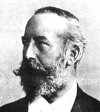 |
|
1863, when his father Ludwig Späth retired, until his death, when the nursery passed to his own son Hellmut Ludwig Späth. With his father Ludwig, Franz was a co-founder of the German Pomologists Association in 1860, and was made an honorary member in 1903. The Späth was one of the world's most notable plant nurseries of the 19th and early 20th centuries, founded in 1720 by Christoph Späth. Franz Ludwig was better known outside Germany as Louis Späth. By the end of the 19th century, the nursery was the largest in the world, occupying 120 hectares. In 1874 Louis built a |
mansion on the site, now part of Humboldt University and, five years later, established an arboretum. His son joined the Nazi party for poltical and commercial reasons, but eventually became opposed to the regime, and he was incarcerated in Sachsenhausen concentration camp where he was executed in 1945. The nursery closed in 1944, and in 1947 the arboretum passed into public ownership and became known as the Späthsches Arboretum.
- spalding'ii: named for Henry Harmon Spalding (1803-1874), a Presbyterian missionary and educator. He was born at
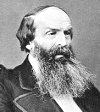 |
|
Prattsburgh, New York, and was given by his young unwed mother to strangers, Mr. and Mrs. Andrew Broat, Jr. at the age of 14 months. He had no schooling growing up but by the age of 21 had studied grammar and learned to read and write. When Henry became a Christian he joined the Presbyterian Church in 1826. He became so well educated that he became a teacher for a time. In 1828 Henry devoted his life to becoming a missionary. In 1831 he met Eliza Hart who also wanted to be a missionary, and they were married in 1833. He graduated from Western Reserve College in |
1833, and entered Lane Theological Seminary in the class of 1837, but left without graduating upon his appointment in 1836 by the Boston-based American Board of Commissioners for Foreign Missions as a missionary to the Nez Perce Indians of Idaho. By boat and wagon trail, with missionaries and fur-traders, in 1835 and 1836 they traveled west to Cincinatti, St. Louis and Liberty, Missouri, and across the Rockies to what are today the states of Wyoming and Idaho, where they established at Lapwai the first white home in Idaho and brought the first printing press into the territory. He developed a written script for the Nez Perce language and translated parts of the Bible into that tongue. He was not as well liked by the tribal peoples as was his wife. He was inflexible on gambling, liquor, and polygamy and reproved many people and even went as far as whipping some Nez Perce or having them whip each other. The Wikipedia article says that “where she sought to understand them, he sought for them to understand him,” and he was dismissed for a time by the American Board but later reinstated. In 1847 occurred the Whitman massacre when fourteen people at a mission in Washington were murdered by Cayuse indians who blamed them for introducing deadly diseases. There was some thought that the Spaldings might be in danger too, but having headed for Fort Walla Walla, Henry rejoined his family and were protected by friendly Nez Perce, but soon abandoned the mission site at Lapwai and traveled down the Columbia to Oregon City, Oregon. The American Board eventually decided to make the abandonment of the mission permanent, and the Spaldings in their new home became involved in education, with Eliza becaming the first teacher at Tualatin Academy, which eventually grew into Pacific University, and Henry serving as an Academy trustee for many years. In 1849 they relocated to Brownsville, Oregon, in the southern part of the Willamette Valley. Spaulding served as pastor of the Congregational Church. He was also postmaster and acted as commissioner of common schools for Oregon between 1850 and 1855. Eliza died in 1851, and in 1853 Henry married Rachel Smith, the sister-in-law of Oregon missionary John Smith Griffin, who had arrived the previous fall. He returned to the Nez Perce in September 1859, and to Lapwai in 1862. In the late 1860s, he was back in Brownsville. He blamed much of his difficulties in the mission field on the Catholic Church, much as he had for the Whitman massacre, and on the federal government. In 1870 he traveled to San Francisco, Chicago, New York City, Boston and Washington, D.C. where he testified before the US Senate, returning to the Northwest later in the year. The following year he created a federally sponsored Indian school under the Peace Policy to the Indians sponsored by Ulysses S. Grant, and continued his missionary work in the Idaho and Washington territories. He died in Lapwai. The only taxon in California with this epithet is Astragalus spaldingii.
- Sparax'is: from the Greek sparassein or sparaxo, "to
tear," relating to the bracts which are lacerated or cut into
segments. The genus Sparaxis was published by John Bellenden Ker Gawler in 1802.
- Spargan'ium: from the Greek and Latin name sparganion used
by Pliny and Dioscorides and derived from sparganon, "diaper,
ribbon, swaddling band," applied to this genus because the leaves
are ribbon-like. The genus Sparganium was published by Carl Linnaeus in 1753.
- sparsiflor'a/sparsiflor'um/sparsiflor'us:
sparsely-flowered.
- Sparti'na: from the Greek spartine,
a cord made from Spartium junceum (Spanish broom), probably used as a name for this genus because of its tough leaves and stems. The genus Spartina was published by Johann Christian Daniel von Schreber in 1789.
- spartio'ides: like genus Spartium.
- Spar'tium: from the Greek word sparton meaning "broom," alluding to the brooms which used to be
made of plants with the name of esparto grass. The genus Spartium was published by Carl Linnaeus in 1753.
- spatha'cea: means "with a spathe,"
referring to the large, colored bracts that enclose the flower cluster.
- spathula'ta/spathula'tum: shaped like a spatula, from the Latin spatula, "a flat piece," typically referring to flat leaves. A website from University of California AgriculturE and Natural Resources has this to say: "The specific epithet or species name spathulata is derived from the Latin spathulatus, meaning a broad rounded upper part tapering gradually downward into a stalk (spoon-like)."
- spathulifo'lium: with spatulate or spoon-shaped
leaves.
- spatula'ta: spoon-shaped.
- specif'ica: the only thing I have for this name is that the prefix speci is Latin for "species, a shape, kind or sort, a particular kind," an explanation that doesn't really explain anything. Probably refers to Late Latin specificus, “specific, particular,” from Latin speciēs, “kind” and faciō, “make.”
- specifor'mis: the authors of this taxon, Alva Day Grant and Verne
Edwin Grant, described it as being most similar to G. c. var. speciosa,
and this may be the intended meaning of the name.
- specio'sa/specio'sum/specio'sus:
showy.
- spectab'ile/spectab'ilis: spectacular, from the Latin spectare, "to look, observe," and -abilis, "able or worthy to be."
- speculario'ides: like the genus Specularia, the Venus' looking
glass, from Latin speculum, "a mirror."
- spen'cerae: named for Mary Evelyn Fisk Spencer (Mrs. James Magoffin Spencer) (1841-1940). Mary Fisk Spencer came from Munich to Palm Springs each year until the outbreak of World War I when she moved to San Diego and from 1915 to 1928 collected some 3,000 specimens in the more arid regions of San Diego County.
- Sper'gula: from the Latin spargo, "to
scatter," alluding to the discharge of seeds. The genus Spergula was published by Carl Linnaeus in 1753.
- Spergular'ia: a Latin derivative of Spergula. The genus Spergularia was published by Jan Svatopluk Presl and Carl Bořivoj Presl in 1819.
- spergulariifor'me: having the form of genus Spergularia.
- sperguli'num: scattering.
- -sperma: a suffix which refers to seeds, e.g. platysperma, "flat-seeded,"
pterosperma, "having winged seeds," oligosperma, "few-seeded,"
disperma, "two-seeded," brachysperma, "short-seeded."
- Spermol'epis: from the Greek sperma, "seed," and lepis, "scale," meaning "scale-seeded"
for the bristly or tubercled fruit. The genus Spermolepis was published by Constantine Samuel Rafinesque in 1825.
- sphacela'ta: withered as if dead, from the Greek sphacelata/sphakelatos, meaning "gangrened, diseased, with brown or black speckling."
- Sphace'le: Stearn says "from Greek sphakos, "sage," from resemblance in foliage." The website Definitions says "Sphacele refers to the necrosis or death of tissue due to lack of blood supply or other causes, typically resulting in a darkened, discolored, and often foul-smelling area of tissue," although this may have nothing to do with its botanical meaning. The genus Sphacele was published by George Bentham in 1829, and appears currently to be Lepechinia.
- Sphaeral'cea: from the Greek sphaira,
"a globe," and alcea, a related genus, referring
to the spherical fruits, the common name of this genus being "globe-mallow."
The genus Sphaeralcea was published by Auguste François César Prouvençal de Saint-Hilaire in 1825.
- sphaer'icus: spherical.
- sphaerocar'pa: orbicular-fruited, with spherical fruits, from sphaira, "a globe," and karpos,
"fruit."
- sphaeroceph'alus: from the Greek meaning
"sphere- or round-headed."
- Sphaeromer'ia: from the Greek sphaira, "a sphere,"
and meris, "a part, portion," thus meaning "spherical-divisioned."
The genus Sphaeromeria was published by Thomas Nuttall in 1841.
- Sphaerophy'sa: from the Greek sphaira, "sphere or globe,"
and physa, "bladder," thus "sphere bladder"
for the shape of the fruits. The genus Sphaerophysa was published by Augustin Pyramus de Candolle in 1825.
- Sphaerop'teris: from the Greek sphaira, "sphere or globe," and pteris, "fern." The genus Sphaeropteris was published twice, first by Johann Jakob Bernhardi in 1801, and then by Nathaniel Wallich in 1829.
- Sphenoph'olis: from the Greek sphen, "wedge," and pholis or pholidos, "scale, horny scale,"
referring to the shape of the upper glume. The genus Sphenopholis was published by Frank Lamson Scribner in 1906.
- Sphenoscia'dium: from the Greek sphen,
"wedge," and sciados, "umbrella," referring
to the umbel. The genus Sphenosciadium was published by Asa Gray in 1865.
- spi'cant: tufted.
- spica'ta/spica'tum: with flowers in spikes, from Latin spicatus, "spiked,"
referring to the spike-shaped inflorescence.
- spi'ca-ven'ti: spica is presumably from the Latin spica, "a
point or spike, or an ear of grain" and venti refers to
the wind, so maybe this means something like "a windblown spike." The taxon in California is Apera spica-venti, some of the common names for which are wind grass, wind-spike grass, windbent grass or wind grass.
- spicifor'mis: spike-shaped.
- spiculifo'lia: with spiky leaves.
- Spies'ia: possibly for Johann Karl Spies (Spiess) (1663-1729), a German professor at the University of Helmstedt born in Wernigerode. He was court physician of the Duke Anton Ulrich of Brunswick. The genus Spiesia was published by Nöel Martin Joseph de Necker in 1891.
- spillman'ii: named for William Jasper Spillman (1863-1931), a botanist, agronomist, science teacher, and plant genet-
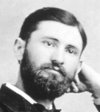 |
|
icist considered to be the founding father of agricultural economics. He was born in Lawrence County, Missouri, as William Spilman, into a family of fifteen children that lived on a 200-acre southwest Missouri farm. His father was accidentally killed when he was just 7, only a month before the birth of his youngest sibling. He presumably received some form of early education, and began teaching at a rural school near his home in his mid-teens. Later he enrolled at the University of Missouri at Columbia where he received a BS in 1886, following which he spent three years as a |
teacher at Missouri State Normal School, Cape Giradeau and married Miss Mattie Ramsay. It was while at college that he changed the spelling of his name from Spilman to Spillman. In 1889 the Spillmans moved to Oregon where he was appointed teacher of science at the Oregon State Normal School, which today is Western Oregon University, at Monmouth. He received his MS in 1890 from the University of Missouri in absentia. Wikipedia goes on to say: “The Spillmans remained in Monmouth until 1894, the year after E.A. Bryan became the third president of the newly opened Washington Agricultural College and School of Science, now Washington State University, in Pullman. Bryan invited his former colleague to teach agriculture. His preparation for this new assignment consisted of his farm childhood, his scientific training and several weeks of observation at the University of Wisconsin. During his brief tenure at Washington's land-grant college, Spillman established the economically important wheat breeding program that continues to this day. He asked the farmers of the fertile Palouse region what they grew and what they needed, the latter being a winter wheat. He used genetics as well as research trials to develop the varieties of wheat necessary for growers to continue to farm. In addition, he began to concentrate on the economics and methodology of practical agriculture for the farmer. He became known as the man with the knowledge to assist the farmer, not just a laboratory theorist. It was at Pullman that, involved in experiments to hybridize wheat adapted to the growing conditions of the Palouse country [a distinct geographic region of the northwestern United States, encompassing parts of north central Idaho, southeastern Washington, and, by some definitions, parts of northeast Oregon], Spillman independently rediscovered Mendel's Law of Heredity. He has been credited with a major role in the acceptance of Mendel's Law by scientists and agriculturalists. His discovery was published in a November 1901 paper titled "Quantitative Studies on the Transmission of Parental Characters to Hybrid Offspring." In 1902 he accepted a position with the US Department of Agriculture following the reception of his paper on his wheat-breeding experiments presented at the meeting of the Association of American Agricultural Colleges and Experiment Stations in Washington, D.C. in November, 1901. Here he, and a select crew which followed him from Pullman (as an earlier group had followed him from Monmouth), laid the groundwork for the scientific management of farms. Although hired as an agrostologist (or expert on grasses), Spillman's overwhelming interest in farm management coupled with the nearly free hand given to him by the department produced several bulletins, speeches and other communications directed to the farmer's needs. In 1905 the Office of Farm Management was organized with Spillman as the head, a position he retained until 1918 when a disagreement with the secretary of agriculture elicited his resignation. Subsequently, he obtained a position as editor of the influential Farm Journal. This provided a forum for his many and diverse approaches to agriculture. He retained this position until the farm slump and a subsequent loss of advertising revenue in 1921 forced the Journal to cut back its staff. Almost immediately, Spillman was asked to rejoin the Department of Agriculture and was again given a free hand. Among his many other activities, Spillman was asked to participate in the efforts of the 1927-1928 Survey of Indian Affairs. Spillman's role required visiting reservations across the country and reporting on their economic use and potential, particularly in relation to agriculture. The final report of the Survey was published as The Problem of Indian Administration (Baltimore: Johns Hopkins Press, 1928). He also served as part-time professor of commercial geography at the Foreign Service School of Georgetown University from 1922 until 1931. Spillman remained with the USDA until his death in 1931.” In 1910 he received an honorary doctorate from the University of Missouri. (Photo credit: Alchetron)
- Spina'cia: from the Latin spina, "a prickle or thorn,"
derived from some Arabic or Persian word. The genus Spinacia was published by Carl Linnaeus in 1753.
- spines'cens: from the Latin spina, "spine, thorn, prick or prickle' and -escens, "becoming like," i.e. the thorns are incompletely formed.
- spino'sa/spinos'um/spinos'us:
from Latin spina for "thorny, spiny," and spinosus, "full of spines."
- spinosep'alum: with spiny sepals.
- spinulo'sa: from the Latin for "minutely
spiny."
- Spirae'a: from the Greek speiraira, "a plant used for
wreaths or garlands," from speira, "spiral or twisted."
The genus Spiraea was published by Carl Linnaeus in 1753 and is called meadowsweet, hardhack or just spiraea.
- spira'lis: spiral.
- Spiran'thes: from the Greek speira, "spiral or coil," and anthos, "flower," referring to the coiled or spiral
character of the inflorescence, and hence the common name "ladies
tresses." The genus Spiranthes was published by Louis Claude Marie Richard in 1817.
- Spirode'la: from the Greek speira, "a cord," and delos, "evident," meaning "visible thread"
and referring to the roots. The genus Spirodela was published by Matthias Jacob Schleiden in 1839.
- spis'sa: thick, crowded, dense, from the Latin spissus, “crowded.”
- spitha'mea: possibly from the Latin spithama, "a span," referring to it reaching the height of a span, the distance on a human hand from the tip of the thumb to the tip of the little finger.
- spjut'ii: named for Richard Wayne Spjut (1945- ), an American botanist and taxonomist born in San Francisco. He received a BS in biology and wildlife management in 1970 from Humboldt State University at Arcata and an MA for a California teaching credential in 1971. He worked first as an assistant laboratory instructor in plant taxonomy at Humboldt State, then as an assistant curator in the cryptogamic herbarium. From 1970 to 1972 he was a contract botanist for the USDA/NCI anti-cancer screening program in California. From 1972 to 1997 he was a botanist at the USDA Agricultural Research Service at Beltsville, Maryland. In addition to anti-cancer screening of plants, he also studied wild relatives of agricultural crops and the classification of fruit types. For a number of years he was a research collaborator and associate at the Smithsonian Institution. He established World Botanical associates in 1983 to explore plants for new medicines, a project which took him to Australia, Mexico, Puero Rico and Hawaii. From 1972 to 1976 he collected in East Africa while working in the Medicinal Plant Resources Laboratory which worked with the National Cancer Institute. In East Africa he collected plants in Kenya, Uganda and Tanzania, and also in Ghana and Zambia. He is the author of A Systematic Treatment of Fruit Types, and two other projects are in preparation, Dictionary of Fruit and Seed Biological Terms with Dr. Wolfgang Stuppy and Trees and Shrubs of Kern County, California. Most of this information comes from the book East African Plant Collectors by Diana and Roger Polhill.
- splen'dens: splendid.
- Sporob'olus: seed-thrower, from the Greek spora or sporos, "seed or spore," and bolis or bolos,
"a casting," in the sense of throwing or dispersing seeds, also from boleo, "to throw,"
referring to the free seeds in many species of this genus that are sometimes forcibly ejected when the usually mucilaginous fruit wall dries. The genus Sporobolus was published by Robert Brown in 1810.
- Spragu'ea: named for botanical, ornithological and landscape artist Isaac Sprague (1811-1895) of Cambridge, Mass., a
 |
|
collaborator of Asa Gray, and an assistant to John James Audubon on an expedition up the Missouri River in 1843, on which he discovered the uncommon bird which was named in his honor Sprague's pipit. He was considered America's best known botanical illustrator of his day. He was born in Hingham, Massachusetts, and was apprenticed to his uncle as a carriage painter. He met Gray in 1845 and illustrated several of his works. He also illustrated Asa Gray and John Torrey's various volumes of the US War Department's Reports (1855–1860), as well as works for George B. |
Emerson, George Goodale, and Alpheus Baker Hervey. He illustrated many of the species sent back from the west to Torrey and Gray. His original drawings are mostly at the Hunt Institute for Botanical Documentation at Carnegie Mellon University, the Boston Athenaeum, the Boston Museum of Fine Arts, and Harvard University. He also did landscapes and ornithological painting. The genus Spraguea was published in 1851 by John Torrey. In 1960, Harvard University's Houghton Library exhibited approximately 100 of Sprague’s paintings, drawings and illustrations. In 2003 Sprague's works were included in the Hunt Institute’s exhibition American Botanical Prints of Two Centuries.
- sprengel'ii: named for Kurt Polycarp Joachim Sprengel (1766-1833), a German botanist and physician born at
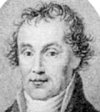 |
|
Boldekow in Pomerania. His uncle was the distinguished botanist Christian K. Sprengel and his father was a clergyman. He received a good early education and showed great aptitude in languages, Latin and Greek, also Hebrew and Arabic. Later he mastered five modern European languages, and gained a solid foundation in the natural sciences. At the age of 14 he published a small work called Anleitung zur Botanik für Frauenzimmer (Guide to Botany for Women). At 17 he began working as a private tutor and studied theology and philology in his spare time. He entered the University of |
Halle intent on studying theology and medicine, but soon concentrated solely on medicine, graduating in 1787 with a dissertation on nosology (the branch of medical science dealing with the classification of diseases). In 1789 he was appointed extraordinary professor of medicine at his alma mater, and in 1795 was promoted to be ordinary professor. He was particularly interested in the history of medicine and botany. He also made many improvements in the details of both the Linnaean and the natural systems of classification. He taught pathology, legal medicine, semeiology (the study of signs and symbols and their use or interpretation), medical history, and botany at the University. After 1800 he devoted more attention to botany and became the director of the University’s botanical garden and established an extensive herbarium. Wikipedia adds the following: “His contemporaries considered Sprengel to be a keen classical scholar and historian. His most important publication was a five-volume medical history, Versuch einer pragmatischen Geschichte der Arzneikunde. Although it became the standard work on the subject for nearly a century, Sprengel modestly labeled it an ‘attempt’ to portray medicine chronologically in the various historical periods. Sprengel called his work a ‘pragmatic’ history of medicine written with a definite utilitarian purpose. In this approach he followed the historical conceptions prevalent during the Enlightenment, which raised the hope of a perfected future, if only the shackles of superstition could be unfastened and the path of reason followed. Therefore Sprengel’s goal was to present the medical past with all its errors and pitfalls, in the hope that these aberrations would provide valuable lessons and reveal the basic truths on which a more rational medicine could be developed. Sprengel’s fame was further enhanced by his numerous translations—many of them from English authors—and his editorship of five journals dealing with medical and botanical subjects. When defending his beliefs or attacking those trends in medicine that he profoundly disliked, he wrote clearly, incisively, and to the point, without allowing petty personal arguments to vitiate his criticism. Although hampered by inadequate optics and preparation techniques, Sprengel strongly promoted the microscopic examination of plants and studied their structure, developing his own theory of plant-cell formation.” In 1809 he became correspondent of the Royal Institute of the Netherlands and in 1810 was elected a foreign member of the Royal Swedish Academy of Sciences.
- spreng'eri: named for Carl Ludwig Sprenger (1846-1917), a German botanist born at Güstrow, Mecklenburg. One
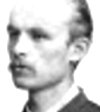 |
|
source indicates that he was orphaned at an early age and lost his hearing beginning as a young adult, while another source says he was born deaf which I think is incorrect. He attended elementary school and was apprenticed to a commercial gardener. Around 1870/1871 he was involved in the German-French War, particularly at the Battle of Orléans. In 1875 he and his cousin leased a nursery, and then a seed shop. Not long thereafter pneumonia and a surgical procedure for his hearing forced him to seek a more southerly locale, and he found employment with a German |
count's family on the Borromean Islands in Lago Maggiore. From 1877 until 1907 he lived in Naples , and was a partner in the Leipzig horticultural house of Dammann & Co. of San Giovanni a Teduccio. He collected seeds for botanical gardens and grew strawflowers. and established a nursery in Vomero called the Hortus botanicus Vomeriensis near the foot of Mt. Vesuvius, selling fruits and vegetables for export. He communicated with botanical experts all over the world and experimented with different plant cultures. The ornamental Asparagus sprengeri, which has found general distribution, and the Magnolia sprengeri were two of his successes. Hundreds of his best specimens were covered with ash from the eruption of Mt. Vesuvius in 1906. In 1907 he became the supervisor of a garden on the island of Corfu belonging to Kaiser Wilhelm. At the outbreak of World War I he was denied permission to return to Naples and he was imprisoned by the Serbs, but was released. He died at Corfu. (Photo credit: My Heritage)
- Sprenger'ia: possibly named for the German court pharmacist Philipp Stephan Sprenger (1536-c.1608) (from David Hollombe). A German website says: "As early as the late 16th century, there was a garden with medicinal plants on the Schlossberg, the then famous “Hortus Medicus”. It was run by Philipp Stefan Sprenger, the Elector’s court pharmacist in Heidelberg." Another possibility for the specific epithet sprengeri would be Carl Ludwig Sprenger (1846-1917), a German botanist and nurseryman in Vomero, Italy, "who bred and helped introduce many new plants such as T. sprengeri into the horticultural trade. He was a partner in Dammann and Co, a nursery in Naples where he lived from 1877 to 1907."
- springvillen'sis: of or from Springville in Tulare County.
- sproul'ii: named for botanist Fred T. Sproul (1949- ), a member of the CNPS and the Board of Advisors with Wildlife Research Institute, lives in Ramona, California.
- spruc'ei: named for Richard Spruce (1817-1893), a British botanist specializing in bryology. He was born in a small
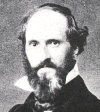 |
|
village in Yorkshire, and was never of robust health, being plagued from a young age with bronchial troubles. After training under his father, a local schoolmaster, and taking lessons in Latin and Greek from an old schoolmaster named Langdale, Spruce began a career as a tutor first at Haxby and then Yorkshire, and then as a mathematics master at St. Peter's School, York between 1839 and 1844. He began collecting botanical specimens in Yorkshire in 1833 and compiled a list of 403 species arranged alphabetically which was his first major contribution to local botany. By the early 1840s |
he was an accomplished bryologist. In 1842 he visited the Irish botanist Thomas Taylor who was also focusing on bryophytes, staying with him and studying his herbarium. In April, 1845, he published in the London Journal of Botany descriptions of 23 new British mosses, about half of which he had discovered himself. That year he also published his "List of the Musci and Hepaticae of Yorkshire" in The Phytologist. The list included 48 mosses new to the English flora and 33 new to Yorkshire. In 1845-1846, having come to the attention of William Jackson Hooker and at the recommendation of the Royal Botanic Gardens at Kew which Hooker was the director of, he made a trip to the Pyrenees, and in 1846 published "Notes on the Botany of the Pyrenees," following it with a more technical article, "The Musci and Hepaticae of the Pyrenees," published in 1849. Once again Hooker proposed an expedition for Spruce, this time to Brazil. Spruce spent a year at Kew learning about tropical botany and arrived at Brazil in mid-1849, meeting the well-known naturalists Alfred Russel Wallace and Henry Walter Bates, and traveling the tributaries of the Amazon and occasionally crossing paths with them. A website of the Yorkshire Philosophical Society says: “Spruce was singularly ill-suited to labour in tropical jungles; his health complaints were continuous: catarrh, bilious disorders, gallstones and other diseases, both real and imagined. Added to this he was plagued with parasitic insects and bouts of malaria; in the Andes he suffered a sudden and mysterious paralysis that left him unable to sit upright at a desk for the rest of his life. Yet what he lacked in physical strength he more than made up for in mental endurance. He survived the most terrible conditions for fifteen years in the Amazon and Andes.” At this time malaria was a great threat in the world and especially for European explorers and colonizers of Africa, India and South America. Cinchona or quinine had already been synthesized and found to be an effective treatment, but the search for large populations of available cinchona trees was continuing. The explorer Clements Robert Markham was appointed to a government office that worked closely with the East India Company; he eventually came to the attention of the officials who ran the India Office. By the 1850s as many as two million adults a year were dying of malaria in India and a further twenty-five million were been afflicted with the disease. Plans were made for the trees to be established in India, thereby overcoming the difficulties being experienced in obtaining constant good quality supplies from South America, and competing with the Dutch and other interested countries. Markham was lacking in expert botanical knowledge, but he was aware of Spruce’s work and knew that he was in South America, where the chinchona tree grew naturally. To quote again from the Yorkshire Philosophical Society: “Richard Spruce, commissioned by the India Office, collected under very difficult circumstances one hundred thousand seeds and six hundred plants, which he then conveyed to the coast, avoiding warring factions and Andean civil war, finally having them shipped to India. His report on this undertaking was published in 1861. His health now completely shattered, he remained on the Pacific coast until 1864. Spruce lay in his hammock, immobilised by the paralysis of his legs, only managing to write a little each day of his reports. After seeing his collection off to India he suffered a further catastrophe. The bank in which he deposited all of his money from the payments for the plants he collected and from the Indian government was declared bankrupt. With all his savings gone he made appeals to various government offices, to no avail. Finally a penurious and broken man, he had to say goodbye to South America, his home for fifteen years, and head for England. There was no one to meet him in England and it took time to write up his learned knowledge of South America. He brought home with him vocabularies of twenty-one Amazonian languages and maps of three previously unexplored rivers. His flowering plants, numbering seven thousand species, were catalogued at Kew with the help of Bentham and his learned colleagues, likewise ferns, mosses and fungi. After a great deal of effort by Spruce and friends he received a small government pension, and the Imperial German Academy gave him the degree of doctor of philosophy.” After his return to England in 1864, Spruce was in poor health because of intestinal disease, and spent much of the rest of his life in and around his dwelling places in Yorkshire. In 1871 he was lodging in Welburn at the house of Georgiana Vause and her daughter Mary Ann Hodgson Vause. Richard retired to head his own household at Coneysthorpe in 1876, and Mary Vause was keeping house for him in 1881 and 1891. Richard died unmarried at Coneysthorpe on December 28th, 1893, and was buried at Terrington beside his parents. His 588-page magnum opus, 'Hepatics of Amazon and Andes,' appeared in the Transactions of the Botanical Society of Edinburgh (1884). His Notes of a Botanist on Amazon and Andes was edited by Alfred Russel Wallace and published posthumously. (Photo credit: Yorkshire Philosophical Society)
- spur'ia/spur'ium/spur'ius: false or doubtful; a species so called sometimes
has other names. Stearn says "false," Gledhill "false, bastard." Wiktionary says "of illegitimate birth or false, spurious." Wikipedia adds this: "The actual meaning of Spurius is unproven. The name was used by the Etruscans in the form Spurie, and it was used by several Roman families that had Etruscan roots, so it has been postulated that it was either borrowed from the Etruscan language, or was a cognate of an Etruscan word meaning something akin to city dweller. Popular etymology, however, connected the name with the phrase, sine patre filius, that is, son without a father, and the explanation that it was given to children born out of wedlock. This was the opinion of Sextus Pompeius Festus, which is accepted by Chase, perhaps surprisingly considering the unlikelihood of anyone deliberately choosing such a name, or passing it down within a family for many generations. This explanation is almost certainly wrong, and is an example of false etymology. However, it probably contributed to the decline in the use of the praenomen [a personal name chosen by the parents of a Roman child], and gave rise to the modern adjective spurious. While it cannot be proven that any Latin praenomina were borrowed from Etruscan, and Spurius was used by a number of gentes of indisputably Latin origin, the explanation that it was connected with a word meaning city or citizen appears reasonably likely." I have found no explanations of what was the application of this epithet to species such as Iris spuria, Kickxia spuria or Galium spurium.
- squa'lens/squa'lum: see squalida below.
- squa'lida: dirty, from Latin squalidus, "rough, coated with dirt, filthy,"
- squama'ta/squama'tum/squama'tus: scaly, having scales,” from Latin squama, “scale.”
- squamo'sus: full of scales.
- squarro'sa/squarro'sus:
means either "scaly or rough" or "with the leaves spreading
at right angles." Stearn says "With parts spreading or recurved at the ends." Merriam Webster says "scurfy, scabby." The Missouri Botanical Garden's "A Grammatical Dictionary of Botanical Latin" says 1: “covered with bodies which spread at right angles, or at a greater angle, from the surface which bears them; or being so arranged” (Lindley, The Elements of Botany); 2: “rough or scurfy with spreading and out-standing processes, as the tips of bracts” (B.D. Jackson, A Glossary of Botanic Terms).
- Stabler'ia: named for British bryologist George Stabler (1839-1910), born at Crayke, which was then in County
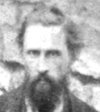 |
|
Durham but now lies in North Yorkshire. His father was a shoemaker and the family moved to Wellburn in 1842, after which two daughters were born. There he was taught by Richard Spruce, the father of Richard Spruce the botanist (see sprucei), and for brief periods by Richard the younger. Later, in the 1860s after Spruce returned from South America, the two became friends and colleagues, and Spruce helped Stabler with his hepatological studies by providing many named specimens. Stabler trained at St. John’s College, York, and became a schoolmaster at Levens in |
Westmorland from 1860 until 1899. He was married in 1869 and he and his wife Sarah had five children. He was particularly interested in liverworts and like his friend Richard Spruce who had Marsupella sprucei named for him, Stabler had Marsupella stableri named in his honor. The following is quoted from an article on a British Bryological Society website by Mark Lawley: “Stabler was a close friend of his Levens neighbour James Martindale Barnes, who collected mosses and edited William James Linton’s Ferns of the English Lake District. Another botanical friend and neighbour of Stabler’s was the lichenologist Joseph Anthony Martindale. The three men botanized regularly in the English Lake District, Furness and Amounderness. They would spend a weekend at each others’ houses, with a long botanical ramble on the Saturday, followed by evenings reviewing their spoil. Stabler and Martindale walked from Staveley (where Martindale lived) to Mardale (Stabler’s favourite valley), collect plants and then walk back. They also visited more distant ground, for example Mallerstang, Wild Boar Fell, and Warcop. Stabler and Martindale botanized on the Isle of Man in 1873, and Stabler visited Wales in 1883. He collected bryophytes mainly from the late 1860s (coinciding with Spruce’s return to England) until the late 1880s, by which time his eyesight was troubling him. His catalogued herbarium of about 7,000 specimens is at Kendal Museum, together with two bound volumes containing the specimens referred to in Stabler’s papers on ‘The Hepaticae and Musci of Westmorland’, published in The Naturalist in the 1880s and 1890s. The museum at the department of botany, Manchester University, also has several hundred of Stabler’s liverworts, some of which probably came from the herbaria of Richard Spruce and Benjamin Carrington. George Stabler’s health concerned him as early as 1874, when he was in a ‘weak state of health.’ By 1881, the sight in his right eye was bothering him, and in May 1895 he sustained a serious accident to his left eye, which necessitated its removal a week later. His incapacity led to the appointment of an assistant master at the school, and in December 1899 he became obliged to retire following development of iritis [inflammation of the colored part of the eye (iris)] in his right eye. Stabler’s loss of sight in later life also prevented him from pursuing his bryological interests. He became totally blind for the last two years of his life, ‘groping pathetically about the roads near his home, unable to see the growing plants he loved so well.’ ” Stabler died at Levens on January 4th, 1910. The genus Stableria was published by Sextus Otto Lindberg in 1890. (Photo credit: Royal Botanic Garden Edinburgh)
- stachyd'eum: from stachys, an ear of corn or a spike, and deum of uncertain meaning.
The specific epithet has something to do with having a spiciform inflorescence.
The common name of this taxon is spiked or Rocky Mountain larkspur.
- stachydifo'lia: with leaves like genus Stachys. The taxon in the California flora is Gamochaeta stachydifolia.
- Sta'chys: from the Greek stachys for
"ear of grain" or "a spike," in reference to the
spike-like form of the flowers. The genus Stachys was published by Carl Linnaeus in 1753.
- staechadifo'lium: according to David Hollombe, an alternative spelling
for stoechadifolium (see below).
- stagna'lis: found in stagnant water, from the Latin stagnum, "standing water."
- stamin'ea/stamin'eum/stamin'eus: with prominent stamens.
- stand'leyi: named for Paul Carpenter Standley (1884-1963), an American botanist, plant collector and botanical
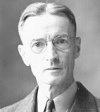 |
|
explorer born in Avalon, Mississippi. He attended Drury College in Springfield, Missouri and New Mexico State College, where he received a bachelor's degree in 1907, and a master's degree in 1908. Upon his graduation he became an assistant botanist there. He was the assistant curator of the Division of Plants at the United States National Museum remaining from 1909 to 1928, when he moved to the Field Museum of Natural History in Chicago. During his time at the National Museum he published an incredible number and variety of papers, including Flora of New Mexico (1915) |
with Elmer Ottis Wooten, a number of families for the Flora of North America (1916-24), Flora of the District of Columbia (1919) with Albert Spear Hitchcock, his influential Trees and Shrubs of Mexico (1926) with over 1,700 pages, and his Flora of the Panama Canal Zone (1928). He continued to produce an astonishing number of publications while at the Field Museum, such as Flora of Costa Rica (1937-40) with 1,616 pages. He retired in 1950 and moved to the Escuela Agricola Panamericana, where he worked in the library and herbarium and did field work until 1956, when he stopped doing botanical work. He retired again in 1957 and moved to Tegucigalpa, Honduras. He was elected to the Washington Biologists' Field Club in 1915 and terminated his membership in 1930. He was the author of an astounding 5,712 species names, was honored with the names of three genera, Standleya, Standleyacanthus and Standleyanthus, and 222 binomial epithets. He died in Tegucigalpa. (Photo credit: Cactus and Succulent Society of America)
- Stanford'ia: named for Amasa Leland Stanford (1824-1893), an American tycoon, industrialist, politician, and co-
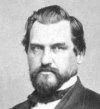 |
|
founder with his wife, Jane, of Stanford University. He was born in Watervliet, Albany County, New York and attended Clinton Liberal Institute and studied law at Cazenovia Seminary in Cazenovia, New York, and later in Albany. He entered the law offices of Wheaton, Doolittle and Hadley in Albany in 1845 and was admitted to the bar in 1848, moved to Port Washington, Wisconsin, and married Jane Elizabeth Lathrop in 1850. After he began practicing law, his father-in-law presented him with a very fine law library, but it was destroyed in a fire in 1852. This was |
just before he joined his five brothers and went to California at the time of the Gold Rush, became a successful merchant as the keeper of a general store and had a successful wholesale business. He served as a justice of the peace and after moving to Sacramento in 1856 helped organize the Sacramento Library Association, which later became the Sacramento Public Library. After running unsuccessfully in 1859, he was nominated again and elected to one term as the governor of California (1862-1863) and subsequently eight years as senator. He was elected president of the Central Pacific Railroad in 1861, a position he held until his death. With several others in 1868 he formed the Pacific Union Express Company which subsequently merged with Wells Fargo in 1870. For the rest of his life he was on the board of directors of Wells Fargo. He also started the Pacific Mutual Life Insurance Company (now Pacific Life) and served as its first president from 1868 to 1876. He and his associates gained control of the Southern Pacific Railroad in 1868 and Stanford was elected president. He presided at the joining of the Central Pacific Railroad and the Union Pacific Railroad at Promontory, Utah, on May 10, 1869, and was given the honor of driving the last spike. After moving to San Francisco in 1874, Stanford was appointed president of the Occidental and Oriental Steamship Company, the steamship line to Japan and China. He was elected to the Senate from California in 1885. He owned two wineries including a 55,000-acre ranch which contained the largest vineyard in the world, and also owned horse ranches and bred racehorses and trotters. While in the Senate he served for four years as chairman of the US Senate Committee on Public Buildings and Grounds. All that he owned and controlled represented a fairly staggering amount and to call him a robber baron would be quite accurate. His wealth toward the end of this life, in today’s dollars, was about a billion and a half. To develop his university, he donated what would today be about a billion dollars. He died of heart failure in 1893 and his wife, who was at the time president of the university's board of trustees, lived another twelve years before suffering two strychnine poisoning attempts by one of her employees, the latter of which in Hawaii proved fatal. It has never been proven, but suspicion must clearly be cast on David Starr Jordan, the new president of the university whom Jane Stanford was apparently seeking to have removed from his position. The genus Stanfordia in the Brassicaceae was published in 1880 by Sereno Watson.
- stanfordia'na: named for Leland Stanford, Jr. (1868-1884), known as Leland Dewitt Stanford until the age of 9,
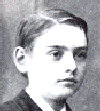 |
|
beloved and only son
of Leland Stanford, California governor and senator, builder of the
transcontinental railroad, and founder of Stanford University. Leland,
Jr., on a tour of Europe with his parents, fell ill in Athens, was rushed to Italy for medical treatment, first to Naples, then to Rome, and eventually to Florence, where he died after weeks of a condition that alternately improved and worsened. His death was attributed to typhoid fever and occurred in 1884 just short of his 16th birthday.
Upon their return from Europe, Leland Sr. and his wife Jane announced that |
they intended to build a college and dedicate it to the name of their son, and so Leland Stanford Junior University, its official name then and now, was born in 1891. The taxon named in his honor is Arctostaphylos stanfordiana which was publshed in 1887 by Charles Christopher Parry. (Photo credit: Find-a-Grave)
- Stan'leya: named for Lord Edward Smith-Stanley, 13th Earl of Derby (1775-1851), an English politician, peer, land-
 |
|
owner, builder, farmer, art collector, ornithologist and member and 2nd president of the Linnaean Society, a position he held until 1834. He was born at Knowsley, the family seat, eight miles east of Liverpool, matriculated at Eton College and received an MA at Trinity College, Cambridge, in 1795. From a website of the American Philosophical Society Library: “Stanley entered Parliament, representing Preston, Lancashire, a spot traditionally held by members of his family. He was, however, not a zealous politician, never attaining prominence in the Whig Party, seldom speaking in |
the House, and stepping down from his seat altogether in 1812. Upon the death of his father in October 1834, Stanley succeeded to the title of 13th Earl of Derby and was made a Knight of the Garter in April 1839.” His interests were mainly in the field of zoology and he was particularly interested in the taxonomy of birds. He was president of the Zoological Society from 1831 until his death and maintained a magnificent private menagerie at his home at Knowsley including rare birds and animals, nearly 100 species of mammals and over 300 species of birds at the time of his death. He used his fortune and his social and political contacts to scour Britain's African colonies for exotic specimens. His zoological museum was equally extensive, boasting over 20,000 specimens of mammals, birds, eggs, and lower vertebrates. Regarding his military career, Wikipedia says: “On 10 November 1796 he was appointed a deputy lieutenant of Lancashire. He was commissioned Colonel of the 1st Battalion of the Lancashire Supplementary Militia on 1 March 1797; this regiment subsequently became the 2nd Regiment Royal Lancashire Militia. He was breveted as a Colonel in the regular Army with seniority from that date, retaining the rank until his regiment was disembodied, which occurred at the end of 1799.” It was not however until 47 years later that he resigned his commission as Colonel. He married Charlotte Margaret Hornby and had one son, Edward Smith-Stanley, who was a future Prime Minister. He might be best remembered as the employer of the writer Edward Lear who was hired to draw the animals of his menagerie. Lear's Book of Nonsense was drawn for Derby's grandchildren. The genus Stanleya was published in 1818 by Thomas Nuttall.
- stan'lyi: named for John Mix Stanley (1814-1872), an American artist-explorer, painter of landscapes, native
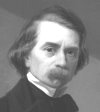 |
|
American portraits and tribal life. He was born and grew up in Canandaigua in the Finger Lakes region of New York. He was orphaned at the age of 12, and two years later was apprenticed to a coach maker. It’s unclear just exactly where and when his interest in painting began, but he moved to the frontier town of Detroit, the largest city in the Michigan Territory, taught himself painting skills and did itinerant work painting signs and portraits. He also painted landscapes and indians of the upper Midwest. One of his major influences was the well-known artist-explorer George Catlin. |
In 1842 he embarked on an expedition to the Oklahoma territory recently populated by relocated tribes from the southeast. He attended councils with Cherokee and Creek indians seeking peace with Texas, and spent much time painting portraits, also meeting with Comanche and other plains indian groups. Stanley painted and sketched many northwest landmarks, which were reproduced in lithographs for inclusion in Isaac Stevens' last volume of the Pacific Railroad Reports. These gained wide circulation and added to Stanley's reputation. Work he did from the trip was publicly exhibited in galleries in several eastern cities. In 1846 he was posted as a "draughtsman" for the Corps of Topographical Engineers attached to Stephen Watts Kearny's battalion, which had helped conquer California in the Mexican-American War, and painting accounts of the campaign. Reaching the Pacific coast, he left the Army and traveled north to Oregon, painting indian scenes and among other things portraits of early Oregon pioneers Maria Pambrum Barclay and Asa Lovejoy. He traveled to Hawaii in 1848 and spent twelve months there painting portraits of King Kamehameha III, his wife, and the royal family. In 1852 there was a major showing of his works at the Smithsonian Institution which went far to cement his reputation as a western artist. When he learned that there was to be a Northern Pacific Railroad expedition heading west in 1853, he joined up along with the junior artist Gustavus Schon to illustrate the surveys that were to be done. Stanley's return to the Atlantic seaboard in January 1854 ended both his western travels and his most creative period. In his remaining years, he operated studios in Washington, D.C., Buffalo, and Detroit, where he died in 1872. Most of his portraiture, more than 200 paintings, and a large collection of maps he had created, was consumed in the great Smithsonian fire of 1865 in which treasures, such as art works, scientific specimens, James Smithson's personal papers, and records of the Institution's early work were destroyed. The irreparable loss of most of his works caused the eclipse of Stanley's reputation for some time in American art history. His appreciation and portrayal of the American West is valued, and today his few surviving works are held by national and numerous regional museums. He helped to found a forerunner of the Detroit Institute of Arts and its School of Arts, and also helped incorporate the National Gallery of Art in Washington, DC. Stanley intended to produce an atlas of the American Indian but, after the loss of most of his paintings in 1865, never completed it. Regarding the fact that his name was Stanley, but the specific epithet is spelled stanlyi, David Hollombe has informed me that Stanley's name was misspelled in Emory's report on nine out of eleven pages on which it appears, including the description of the Opuntia which came to bear his name, Opuntia stanlyi, published by George Engelmann in the report entitled Notes of a Military Reconnoissance, from Fort Leavenworth, in Missouri, to San Diego, in California, including Part of Arkansas, de Norte, and Gila Rivers (1948) prepared by Lieut. Col. W.H. Emory. I'm not sure why the ICBN would not accept the correction of stanlyi to stanleyi since it was based on an error.
- stans: erect, upright, self-supporting, standing.
- stansburia'na/stansburya'na/stansbur'yi:
named for Howard Stansbury (1806-1863), an American civil and
topo-
 |
|
graphical engineer who was placed in charge of the survey of proposed canals
to unite Lake Erie and Lake Michigan with the Wabash River, and made
a survey of the James River in order to improve the harbor at Richmond,
Virginia. The following is from the Utah
History Encyclopedia: "Born in New York City in 1806, Howard
Stansbury was trained as a civil engineer. He married Helen Moody
of Detroit on 1 September 1827. The couple had two children, a daughter
and a son, the latter going on to West Point and serving in the Civil
War. In October 1828 Stansbury secured a |
position with the United
States Topographical Bureau as a civil engineer, and for the next
ten years was employed as a surveyor and supervisor of various public
works in the Midwest and along the Atlantic coast. On 7 July 1838,
Stansbury was granted a commission as a First Lieutenant in the newly
formed Army Corps of Topographical Engineers and was advanced to Captain
in 1840. From 1838 to 1849 he directed projects for the Corps in the
Great Lakes region, at Portsmouth, New Hampshire, and, during the
Mexican War, at some fortifications in the Dry Tortugas in the Gulf
of Mexico. The supreme assignment of his army career was to lead an
expedition in 1849 to the valley of the Great Salt Lake. His orders
directed him to survey and map the Great Salt Lake and its valley
as well as Utah Valley; to evaluate the various emigrant roads in
the area, including the Oregon Trail; and to examine and report on
the capability of the Mormon community at Salt Lake City to provide
food and supplies for overland travelers. During the year he and his
second in command, Lieutenant J.W. Gunnison, spent in Utah, Stansbury
completed his assignment and produced a remarkable report, which also
went through several editions as a private publication. Stansbury's
report along with Gunnison's book, The Mormons, provided the outside
world with an objective look at the Mormons of Utah as well as with
a scientific appraisal of the resources and fauna and flora of this
section of the Great Basin. Captain Stansbury spent the next years,
until the outbreak of the Civil War, improving harbors in the Great
Lakes and building roads in Minnesota Territory. When the war came,
he was appointed as mustering officer at Columbus, Ohio, and later
was placed in charge of recruiting for the state of Wisconsin. Stansbury
served only forty-five days in this post before he died on 13 April
1863 at the age of fifty-six of "disease of the heart."
His obituary noted that his early death came as a result of the "over-exertions
and hardships" endured during his Great Salt Lake expedition.
Stansbury was buried at St. Paul, Minnesota, in 1863."
- stanton'ii: named for Dr. Carey Quillian Stanton (1923-1987), a Santa Barbara-area philanthropist, dedicated preservationist and cattle rancher, born in Los Angeles and died on Santa Cruz Island. His father bought 90% of the island in 1937 and his son Edwin Jr. was killed in France in 1944. When Edwin Sr. died in 1963, his surviviving son Carey inherited those holdings. From 1937, when Los Angeles businessman Edwin Locksley Stanton purchased the western nine-tenths of the island, until the 1987 death of Stanton’s son and heir, Carey Stanton, Santa Cruz Island remained the largest privately owned island in the continental United States. The ranch included about 1,000 head of cattle and was reminiscent of a 19th-century California ranch. In addition, he supervised numerous botanical and historical projects there. He gave permission to the University of California to establish a field station there in 1966. He graduated from Stanford University in 1944 and later received a medical degree from Stanford’s School of Medicine. He practiced internal medicine and pathology for 10 years, but his love of the island and determination to work for conservation became his life. Stanton was a trustee of the Santa Barbara Museum of Natural History and a member of the Santa Barbara Historical Society. Daniel Isaac Axelrod, the author of the taxon Pinus muricata var. stantonii, wrote: “It is a pleasure to name this pine for Carey Q. Stanton, previous owner of most of Santa Cruz Island, who for many years has graciously fostered and encouraged biologists and earth scientists to conduct research there.”
- Stap'fia: named for Otto Stapf (1857-1933), an Austrian born botanist and taxonomist born in Perneck near Bad Ischl.
 |
|
He grew up in Hallstatt where his father was in charge of the salt springs, and he later published about the archaeological plant remains from the Late Bronze and Iron Age mines that had been uncovered by his father. He studied botany at the University of Vienna under Julius Wiesner and after receiving a PhD became an assistant professor of Anton Kerner von Marilaun in 1882. In 1887 he became a Privatdozent (lecturer without a chair) in Vienna. After publishing the results of an expedition conducted by Jakob Eduard Polak, the personal physician of Nasr al-Din, the Shah of |
Persia, Polak sponsored Stapf to conduct a nine-month botanical expedition of his own to southern and western Persia. Upon his return he became embroiled in a controversy with his superior, Anton Kerner, who criticized his travels and publicly accused him of misidentifying plants. As a result of this, Stapf moved to the Royal Botanic Gardens, Kew in 1890. He was keeper of the herbarium there from 1909 to 1920 and became a British citizen in 1905. He was awarded the Linnean Medal in 1927. In May 1908 he was elected a fellow of the Royal Society, and the botanical journal Stapfia was named in his honor. He was also a member of the Austrian Academy of Sciences and the German Botanical Society. In addition to Stapfia, he was also honored with the generic names Ottochloa and Stapfiella. He published on botanical subjects as varied as the genera Aconitum and Paeonia, the floras of India, Africa and Malaysia, and botanical illustration in the monumental Index Londinensis. The genus Stapfia was published by Joseph Burtt Davy in 1898.
- Staphyl'ea: from the Greek staphyle, "a cluster,"
from the flower arrangement. The genus Staphylea was published by Carl Linnaeus in 1753.
- starckea'num/starkea'na/stark'ei: named for Johann Christian Starke (1744-1808), a Polish/German bryologist (student of mosses) and pastor in Silesia. He was born in Drezdenko, Poland, and was an honorary member of the Botanical Society of Regensburg. He was a pastor in Gross-Tschirnau.
- statico'ides: means "like genus Statice."
- stebbinsia'num/stebbins'ii/Stebbinsos'eris: named for George Ledyard Stebbins, Jr. (1906-2000), an American
 |
|
geneticist and according to Peter Raven the "leading plant evolutionary biologist of the century." He was born in Lawrence, New York, and moved with his family to Santa Barbara, California, when he was 8. He attended the Cate School in Carpenteria where he came under the influence of Ralph Hoffmann, a natural history instructor and amateur ornithologist and botanist. Upon graduating from high school, he pursued a major in political studies at Harvard, but switched to botany. He completed an MA in botany in 1929 and a PhD in 1931. In 1932 he took a teaching |
position in biology at Colgate University. During the 1920s and 1930s, evolutionists had been split between the group that saw change happening suddenly as a result of random mutations and the group that believed change occurred more slowly as a result of natural selection. In 1935, Stebbins was offered a genetics research position at the University of California, Berkeley, and was made a full professor in the department of genetics in 1939. Stebbins was largely responsible for what came to be known as the "modern synthesis," combining elements from both sides into an elegant theory that Stephen Jay Gould described as "one of the half-dozen major scientific achievements in our century." He became a professor of genetics at UC Davis in 1950, after spending 15 years at Berkeley and shortly after publishing Variation and Evolution in Plants, considered to be one of the classics in the field of modern evolution, and he retired in 1973. His UC Davis obituary recalls that he was once so absorbed in his own thoughts that he drove 120 miles without noticing a dead rattlesnake on the hood of his car. Another story that illustrates his devotion to his subject has to do with the time that after noticing an interesting plant, he drove his car into a 4-foot ditch, and giving no indication that a problem had occurred, got out and walked over to examine it. Another student has related that the professor once turned to talk to people in the back seat of his car while crossing the San Francisco Bay Bridge and veered into the oncoming lane, fortunately without a disaster ensuing. He loved teaching and mentoring students, and was highly regarded by both faculty and students alike. He remained active after his retirement, and was one of the authors of California's Wild Gardens, a guide to California's native plants in their natural habitats, published by the California Native Plant Society. During his career he served at one time or another as president of the CNPS, the Society for the Study of Evolution, the American Society of Naturalists, the Western Society of Naturalists, the California Botanical Society, and the Botanical Society of America. The genus Stebbinsoseris was published in 1991 by Kenton Lee Chambers.
- steckeria'num: named for Gottlieb Adolph Stecker (1859-1939), a German missionary and botanical collector born at Eibau, Saxony, near Hermhut. He served at a number of Moravian missions in Labrador, Okak, Zoar, and Ramah, where he remained until 1900 ministering to the local Inuit population. In April and May of 1899 he made a voyage of exploration to Ungava Bay, a large bay in northeastern Canada separating Nunavik (far northern Quebec) from Baffin Island. There is no indication that botanical specimens were obtained on this trip however, the season doubtless being too early for flowering material. In 1901 Stecker became superintendent of the Moravian missions in Alaska, but due to his wife’s failing health he retired to Nazareth, Pennsylvania. She died in 1912 and Stecker decided to return to the mission field and went to Quinhagak, on the west coast of Alaska north of the Aleutian Peninsula, where they served until 1917. After his second retirement, Stecker lived with one of his daughters in Tacoma, Washington, where he died in 1939. The taxon Epilobium steckerianum, collected by Stecker in Ramah and published by Merritt Lyndon Fernald, honored “the assiduous collector, Rev. Adolph Stecker, who has supplied us with material of so many interesting and often novel plants from northern Labrador." Stecker was married to Francisca Pietschmann, and they had three children.
- steel'ei: named for Edward Strieby Steele (1850-1942), an American botanist and botanical collector born in Farmingdale, Illinois. His father, James Steele, was involved in helping the Amistad captives return to Africa. Edward attended Oberlin College where he earned an AB degree in 1872 and a Seminary degree in 1877. In 1889, he went to Washington, DC to work on the editorial staff of the Century Dictionary and Cyclopedia. He married Grace Avery King in 1891. After the project he went to work for the federal government in various capacities including a botanical clerk for the US Department of Agriculture as well as an editorial assistant for the United States National Museum, Division of Plants, 1912-1918, and an assistant botanist. In 1932 he moved to Los Angeles, California, when his wife died. He and his niece, Helen Steele Pratt (1883–1965), were botanical co-collectors in Southern California and sent about 350 botanical specimens to the Oberlin herbarium. Helen graduated from Oberlin College with an AB in 1906. She was a naturalist and nature teacher, credited as the main person responsible for California's adoption of the California quail as the state bird. Edward Steele died in Glendale, California.
- Steinhau'era: named for Rev. Henry Steinhauer (1782-1818), a Canadian paleobotanist, paleontologist and Moravian minister born at Haverfordwest, England, the son of a Moravian minister and teacher. The following is quoted from the Geological Society of London: “He attended their Yorkshire school from 1789 and then trained for their ministry in Germany. He returned to teach at Fulneck from 1801 to 1811. Moravians particularly encouraged the study of, and participation in, music and natural history, and Fulneck school had a museum for the latter by 1795. At Fulneck Steinhauer came across the fossil plants found in nearby coal mines. By 1811 he was suffering from consumption. To improve his health he moved temporarily to London where he tried to encourage James Sowerby to undertake a ‘Mineral Botany’ project to parallel Sowerby’s one on fossil shells, Mineral Conchology. Sadly, this failed to come to fruition. Next Steinhauer moved to Bath, where he became a disciple of the stratigraphic methods of William Smith. In 1814 he received a call to teach at the new world Moravian settlement of Bethlehem in Pennsylvania, USA. He presided over the Moravian Seminary for Young Ladies. He set off late in 1815 and there presented his only palaeobotanical paper to the American Philosophical Society in May 1817. This gave scientific descriptions of 10 species of English fossil coal plants and introduced valid binomial nomenclature for such fossils. His large collection of stratigraphically arranged fossils from all over England, and its detailed manuscript catalogue all predating his 1815 departure, survive in Philadelphia. His work has largely been lost sight of because of his early death and the tragic separation of this fine collection from its place of origin. He deserves to be better known.” He died at Bethlehem. The genus Steinhauera was published by Carl Bořivoj Presl in 1838.
- stell'ae/stell'iae: named for Stella Leimoni Tree (Mrs. Stanley Larson Welsh) (1930-2023), an American botanist and plant collector. She was married to the American botanist Stanley Larson Welsh, who worked as professor of integrative biology at the Brigham Young University for 44 years and was the founding curator of that university's herbarium, which is named after him. His fields are North American and Tahitian flora, especially the genera Astragalus, Oxytropis and Atriplex. Stella was born in Coalville, Utah and married Stanley Walsh in 1949 in the Salt Lake City Temple. They had eight children and lived in Orem since 1960. Her obituary in the Orem Daily Herald provides this: “Stella led a life of faith and service. She was a devoted member of The Church of Jesus Christ of Latter-day Saints and held many positions in the church, including Relief Society President. She was a caregiver for her mother-in-law, mother, stepfather, and countless others who crossed her path. She was an avid gardener and preserved thousands of jars of fruit and vegetables for her family. She was a skilled seamstress who made and repaired clothes. She was a tireless quilter whose quilting frames often occupied the front room for weeks on end. She was an excellent baker and cook. She loved flowers and had spectacular beds of iris, peonies, daffodils, and tulips. She loved to read and was rarely seen without a book near her side. She was the first female elected to serve on the Orem City Council where she served for 8 years and was the first elected female mayor of Orem, Utah. She loved Orem and was instrumental in establishing community parks including the Orem Canyon Park, which served as the site for the Timpanogos Storytelling Festival. She helped Habitat for Humanity obtain land for the first house in Utah County. She helped secure the Timpanogos Regional Hospital, and worked on countless other projects in Orem from which the citizens benefit today. After serving as mayor, she served on the boards of Habitat for Humanity, Kids on the Move, Community Action, and the Timpanogos Regional Hospital. She leaves a legacy of kindness, service, and hard work.”
- Stellar'ia: from the Latin stella for "star' because of the star-like shape of the flowers or some
other feature. The genus Stellaria was published by Carl Linnaeus in 1753.
- stellar'is: starry, star-like, with spreading leaves or petals arranged
in a star-shaped fashion.
- stella'ta/stella'tum/stella'tus:
same as above entry.
- stel'leri: named for Georg Wilhelm Steller (Stöhler, Stöller) (1709-1746), a German botanist, zoologist, physician and
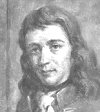 |
|
explorer, who worked in Russia and is considered a pioneer of Alaskan natural history. He was born at Bad Windsheim, near Nuremberg in Bavaria, Germany, where his early education took place. Between 1729 and 1734 he attended several universities, including the University of Wittenberg and the University of Halle (now combined in the Martin Luther University of Halle-Wittenberg). His studies centered on theology, medicine, and the natural sciences, including botany, and in 1734 he traveled to Berlin, where he earned his certification in botany and joined the Russian army, serving |
as a surgeon. He traveled to Russia as a physician on a troop ship returning home with the wounded, arriving in Russia in November 1734. There at the Imperial Academy of Sciences, he met the naturalist Daniel Gottlieb Messerschmidt who had recently returned from his 1720-1727 expedition to western and central Siberia which was the beginning of investigation in geography, mineralogy, botany, zoology, ethnography, and philology. Two years later he married Messerschmidt’s widow and acquired notes from his travels in Siberia that were not handed over to the Academy. Steller went to the Royal Botanical Gardens and left his career behind, training instead in mineralogy, zoology, and botany, and secured an adjunct position with the Royal Academy of Sciences. He had craved adventure since he was a young man, and he was no doubt aware of Vitus Bering’s first Kamchatka expedition from 1728 to 1730, and his second expedition which had been underway for several years. He volunteered to join it and was accepted. Steller met Johann Georg Gmelin in Yeniseisk in January, 1739. Gmelin recommended that Steller take his place in the planned exploration of Kamchatka. Steller embraced that role and finally reached Okhotsk and the main expedition in March, 1740, as Bering's ships, the St. Peter and St. Paul, were nearing completion. Wikipedia describes his participation in this way: “In September 1740, the expedition sailed to the Kamchatka Peninsula with Bering and his two expeditionary vessels sailing around the peninsula's south tip and up to Avacha Bay on the Pacific coast. Steller went ashore on the east coast of Kamchatka to spend the winter in Bolsherechye, where he helped to organize a local school and began exploring Kamchatka. When Bering summoned him to join the voyage in search of America and the strait between the two continents, serving in the role of scientist and physician, Steller crossed the peninsula by dog sled. After Bering's St. Peter was separated from its sister ship the St. Paul in a storm, Bering continued to sail east, expecting to find land soon. Steller, reading sea currents and flotsam and wildlife, insisted they should sail northeast. After considerable time lost, they turned northeast and made landfall in Alaska at Kayak Island on Monday 20 July 1741. Bering wanted to stay only long enough to take on fresh water. Steller argued Captain Bering into giving him more time for land exploration and was granted 10 hours. During his ten hours on land Stellar noted the mathematical ratio of 10 years preparation for ten hours of investigation. While the crew never ever set foot on the mainland, Georg Steller is credited with being the first non-native to have set foot upon Alaskan soil.” He was the first European naturalist to describe a number of North American plants and animals, including the Steller's jay, Steller's sea cow (now extinct), Steller's sea lion, Steller's eider and Steller's sea eagle. A scurvy epidemic killed half the crew of his ship, the St. Peter, partly because they would not follow his recommendations to eat the leaves and berries he had collected. Bering was one of the victims. Finally only twelve members of the crew were able to function, and the rigging was failing. St. Peter dropped anchor on what came to be called Bering Island, but storm winds later wrecked the ship and the surviving crew were forced to spend the winter. Despite the hardships the crew endured, Steller nevertheless was able to study the flora, fauna, and topography of the island in great detail. The following spring they built a small boat out of the remains of St. Peter and returned to Kamchatka. Steller spent the next two years exploring the Kamchatka Peninsula, but died during his overland return journey to Moscow. His journals, which reached the Academy and were later published by Peter Simon Pallas, were used by other explorers of the North Pacific, including Captain Cook. (Photo credit: All About Birds/University of Tyumen)
- stellula'ta: with small star-like markings.
- Stemo'dia: abbreviated from stemodiacra, meaning "a stamen
with two tips." The genus Stemodia was published by Carl Linnaeus in 1759.
- stem'on: a stamen.
- stenan'tha: narrow-flowered, from Greek stenos, "narrow."
- Stenan'thium: from the Greek stenos, "narrow," and anthos, "flower," in reference to the narrow sepals
and petals. The genus Stenanthium was published by Karl Sigismund Kunth in 1843.
- steno-: narrow.
- stenocar'pum/stenocar'pus: narrow-fruited.
- stenol'epis: narrow-scaled.
- stenolo'ba: narrow-lobed.
- Stenomes'son: from the Greek stenos,
"narrow," and messos, "middle," from the
shape of the flower. The genus Stenomesson was published in 1821 by William Herbert.
- stenopet'alum: with narrow petals.
- stenophyl'lus: narrow-leaved, from Greek steno, "narrow."
- Stenotaph'rum: from the Greek stenos, "narrow,"
and taphros, "a trench or ditch," referring to the
depressions or cavities in the axis of the inflorescence. The genus Stenotaphrum was published by Carl Bernhard von Trinius in 1820.
- Steno'tus: from the Greek for "narrowness" from the leaf width. The genus Stenotus was published in 1840 by Thomas Nuttall.
- Stephanomer'ia: name derived from the Greek stephane or stephanos, "wreath or crown," and meros or meris, "division." Southwest Desert Flora says the name is a "reference to the pappus on the cypsela fruit," and FNA says "presumably alluding to appearance of plumose bristles of pappus." The genus Stephanomeria was published by Thomas Nuttall in 1841.
- stephens'ii: named for Frank Stephens (1849-1937). Following are a couple
of quotes from an article I found online
 |
|
called "Frank Stephens,
Pioneer" by Laurence Huey from May, 1938: "Frank Stephens,
who may well be termed one of the few truly pioneer naturalists of
the Southwest, was born in Livingston County, New York, April 2, 1849,
and he died in his eighty-ninth year at San Diego, California, October
5, 1937. [He] always loved the desert ... about 1910 he took up a
desert claim, in La Puerta Valley in eastern San Diego County. During
the next few years he used his spare time to make collections of the
various birds and mammals he found about the place. These specimens, like most of those he had taken during his pioneer days, were sold
to help provide living expenses. William |
Brewster, C. Hart Merriam, C.K. Worthen, University of California and Donald R. Dickey were
some of the more notable purchasers. In 1910, however, he donated
his main collection of some 2,000 birds and mammals to the San Diego
Society of Natural History, and upon the foundation of this gift has
been built all the Society's subsequent activity in the field
of vertebrate research. Stephens' ranch at La Puerta was destined,
in the years that followed, to be the focal point for field adventures
of a number of budding young naturalists, and he never failed to foster
their enthusiasm either by being a member of their party or by entertaining
them if he happened to be there when they arrived." During
the years 1915-1917 he and his wife, Kate Stephens, who would become
the nationally recognized naturalist and paleontologist who served
as curator of collections for the San Diego Society of Natural History
and later as curator of mollusks & marine invertebrates, spent
a great deal of time developing a public natural history museum for
San Diego. "As evidence of the high regard in which Stephens
was held by his fellow scientists, we know that at least fourteen
new species or subspecies were named in his honor, three birds, six
mammals, one reptile, one plant, two insects, and one mollusk. He
joined the American Ornithologists' Union as an associate in 1883
and was honored by membership in 1901. He joined the Cooper Ornithological
Club in 1894 and was made an honorary member in 1912. He was designated
a fellow of the American Association for the Advancement of Science
in 1926, and prior to 1923 was elected both a Patron and a fellow
of the San Diego Society of Natural History. He was a charter member
of the Zoological Society of San Diego and was one of the five founders
of San Diego's now famous zoo. He was also a member of the Biological
Society of Washington and a charter member of the American Society
of Mammalogists. The most important trip ever made by Frank Stephens
on his own account was primarily in the interest of his book on California
mammals, which was published in 1906 after many years of preparation."
- stephenson'ii: named for James Burton Stephenson
(1882-1944), a US Forest Service ranger. "James Burton Stephenson
was born in Texas but came to Orange [County, California] with his
brother, Terry, after the death of their mother when they were children.
A graduate of Santa Ana High School, where he was known as "Eric
the Red" because of his flaming hair, he went to Stanford University
with the reputation as a football star which he lived up to, making
the varsity as a freshman. He left college in 1906 to join the
Forest Service which was just being created. His headquarters
were first at El Toro, then in Corona. In 1921 he became a liaison
officer between the Air Force and the Forest Service. He took
charge of the Palomar ranger district and then established the ranger
station at Descanso. An almost legendary figure of southern
California's back country, Stephenson fought fires, blazed trails,
planted trees, directed and educated travellers in the tree and brush
country, operated lookouts, directed searching parties for lost persons,
sent rescue parties to snowbound mountaineers and in numerous other
ways carried on the duties of the ranger." [Information
from the Santa Ana Register]
- ste'rilis: infertile, sterile, from Latin sterilis, “barren, futile."
- steven'ii: named for Christian Steven (or von Steven) (1781-1863), a Finnish botanist and entomologist born in
 |
|
Fredrikshamn, Finland. He studied at the Academy of Turku, Finland, and then at Jena and St. Petersburg from 1795, receiving his medical doctorate from St. Petersburg University in 1798. JSTOR provides the following: “After working briefly as a doctor he met Friedrich Marschall von Bieberstein, German botanist and explorer in the Crimea, who introduced him to the silk industry. Soon Steven was working as an inspector of silk production in Kislar and in 1803 visited the Caucasus before moving there in 1806 to become assistant director of silk inspection under von |
Bieberstein. Based in Simferopol from then until his death, Steven traveled the area collecting plants and insects and founded the Nikita Botanical Garden in 1812. Directing this garden until 1827 he also traveled in Central Europe in 1820-1821. Around the time of his retirement from the garden Steven became the general inspector of the silk industry for the whole of Russia (1826-1841) and following that was named general inspector for south Russian agriculture as a whole, a role he carried out until 1850. His rich collection of insects was left to the University of Moscow in 1823 and his herbarium was given to Helsinki University in 1861, two years before his death. Steven published several contributions to the flora of Russia, particularly that of the Caucasus region including Stirpes rariores in itinere Caucasico (1913), as well as treatments of the Pedicularis and Saxifraga genera. Some 21 species have also been named after him.” In 1815, he was elected a corresponding member of the Royal Swedish Academy of Sciences. He died in Simferopol, Crimea. (Photo credit: "Christian Steven at the Lower Volga" by Vadim Sagaleyev and Gennady Firsov in Memoranda Soc. Fauna Flora Fennica 90:25-32, 2014)
- stevens'ii: named for Orin Alva Stevens (1865-1979), a North Dakota birder, botanist and author of Handbook of North Dakota Plants, North Dakota Weeds, Wildflowers of North Dakota, Audubon's Journey up the Missouri River 1843, Plants of Bottineau County, North Dakota, Making Use of our Birds and Flowers of the Theodore Roosevelt National Memorial Park. An obituary by Gale Monson in Western Regional News, Vol. 4, No. 1, 1979, relates the following: "A pioneer midwestern bird bander, Dr. O.A. Stevens, died at Sacramento, California on 12 January 1979, at the age of 93. Dr. Stevens was born 17 October, 1885 on a farm near Blue Rapids, Kansas. He was a young naturalist, developing a deep interest in plants, birds, and insects before entering high school. His education was pursued at Kansas State College in Manhattan, where he received a BS degree in 1907. Following a stint as botany instructor at Kansas State, he accepted a position as botany professor and pure seed analyst at North Dakota State College (now North Dakota State University] in Fargo in 1909. Fargo was to be his home, and that of his wife, the former Julia Anna Monroe (whom he married in 1910), for the next 67 years -- as a faculty member of the college until his retirement in 1956, and as professor emeritus until he and Mrs. Stevens moved to California in 1976. Although his main interest lay in botany -- he was to become author of the definitive Handbook of North Dakota Plants (1950) -- he was also keenly interested in bird life. He began banding birds in 1925 and was an active bander for the next 40 years and was still banding on a limited basis until 1976. He prepared an article for the first volume of Bird- Banding (in 1930) and a long essay with the late Myron H. Swenk, a fellow pioneer bird bander, "The Harris's Sparrow and the study of it by trapping," which appeared in the Wilson Bulletin (in 1929) and included a painting of Harris' sparrow by George M. Sutton. He served as secretary of the Inland Bird Banding Association and edited the Inland Bird Banding News for eight years. Dr. Stevens was author of a number of articles on bird behavior and distribution, as well as histories of the pioneer ornithologists and botanists of the upper Missouri River Valley. For a number of years he wrote popular articles on birds for a Fargo newspaper, and thus contributed greatly to public interest in birds throughout North Dakota and adjacent Minnesota. In addition to his notable accomplishments in botany and ornithology, Dr. Stevens was a recognized expert on wasps and wild bees, gathering a collection of more than 12,000 specimens of these insects. He therefore qualifies as a true naturalist, not simply as a specialist in one field. He was unriveled as an authority on the natural history of North Dakota. A mild-mannered and quiet-spoken man, and never one to attempt to further his own ambitions at the slightest expense to anyone, his proven ability, his interest in and encouragement to others, and his innate kindness and integrity won him a host of friends and the sincere respect of his colleagues. He took an active interest in the progress of his students, to whom he imparted wise words of advice. One of those students is the writer. Dr. Stevens' stature as a person and as a scientist was notably confirmed in 1968 when a new natural sciences building complex on the campus of North Dakota State University was dedicated as Stevens Hall. He was awarded an honorary doctor of science degree by the State University in 1948, and the same honor was accorded him by the University of North Dakota in 1965."
- stevio'ides: one source, the Ladybird Johnson Wildflower Center, calls Chaenactis stevioides “Steve’s dustymaidens” but it isn’t named for someone named Steve. Another, Southwest Desert Flora, says that stevioides is named for the Spanish botanist, physician and humanist Pedro Jaime Esteve, but that’s not exactly correct either. The epithet stevioides means “like genus Stevia,” which genus WAS named for Petrus Jacobus Stevus (Pedro Jaime Esteve) (c.1500-1566?), a Spanish botanist and physician, professor of medicine and mathematics at the University of Valencia, born in Sant Mateu del Maestrat, He was the author of commentaries on Nicander and Hippocrates, and of an unpublished flora of the Kingdom of Valencia, and a leading figure in the humanist movement in Spain. He studied in Valencia, Paris, and Montpellier. In 1551, he published the Hippocratic work "Epidemics II" in Greek, with numerous illustrations and a Latin translation. In 1552, he published a critical edition of "Theriaca," a work on the poisons and bites of snakes and scorpions, by the ancient Greek doctor Nicander of Colophon. He made his Latin hexameter version available with Latin and Catalan nomenclature and taxonomy of some plants from the region of Valencia. Later, Esteve wrote a volume on medicinal herbs, which, however, has been lost. He died in Valencia. The genus Stevia in the Asteraceae includes some 240 species that are native to subtropical and tropical regions from western North America to South America. One of these species, Stevia rebaudiana, called honey-leaf or sweet-leaf, is the plant from which the artificial sweetener Stevia is derived. The individual flowers of Stevia rebaudiana are remarkably similar to those of Chaenactis stevioides. The name has been used elsewhere in taxonomy, with Ageratina/Eupatorium stevioides and Revealia stevioides (which is a synonym for the monotypic species Revealia macrocephala), but I have been unable to find pictures of those species to see if they are also similar in appearance to Chaenactis stevioides. The genus Stevia was published by Antonio José Cavanilles in 1797, and Chaenactis stevioides was published in 1839 by William Jackson Hooker and George Arnott Walker Arnott and is called Esteve or desert pincushion.
- Stillin'gia: named for Dr. Benjamin Stillingfleet (1702-1771), a British botanist, translator and the author of the first
 |
|
English language work on the principles of Linnaeus. He was born in Wood Norton, Norfolk, to a physician father. He attended Norwich School and then obtained a BA at Trinity College, Cambridge, in 1723. He first supported himself by serving as a tutor to a relative, William Windham, teaching him for thirteen years. In 1737 he accompanied William on a tour of Italy and Switzerland that lasted for several years. They settled in Geneva and formed a community known as the ‘Common Room’, which was dedicated to the pursuit of literary discussion and play-reading. |
Summers were spent searching for undocumented glaciers in the Alps. Returning to England, Windham and Robert Price, with the assistance of Stillingfleet, published in 1744 ‘An Account of the Glacieres or Ice Alps in Savoy’ which helped to popularize those stupendous works of nature, at that time largely unknown in England and Europe. Stillingfleet was awarded a yearly pension by the Windham family, in partial recognition of William’s being made a fellow of the Royal Society, an election resulting from their study of glaciers. His wide-ranging intellectual curiosity led him naturally to the study of botany. The Oxford Dictionary of National Biography says: “After an initial study of the early Greek writers Dioscorides and Theophrastus and of more recent botanists such as Gerard and Ray, Stillingfleet later (1750–55) came to recognize the superiority of the system of classification promulgated by Linnaeus. The works of the great Swedish botanist were little known in England at that time and it was the publication in 1759 of Stillingfleet's Miscellaneous Tracts Relating to Natural History, Husbandry and Physick, that gave the Linnaean system wider recognition. [William Hudson's work Flora Anglica is often given credit for being the first application of Linnean principles to botany in England, but Stillingfleet's opus predated Hudson's by at least two years.] This work, Miscellaneous Tracts, was Stillingfleet's most significant achievement, consisting as it did of translations of selected essays from the Amoenitates academicae (Philosophical Diversions) of Linnaeus and his pupils. Stillingfleet added his own comments and concluded the work with an original treatise, Observations on Grasses, which included suggestions for the best species for the improvement of turf and the nourishment of cattle. A second edition was published in 1762 with several additions including a 'Calendar of flora' and eleven plates, drawn by Robert Price, illustrating the different species of grasses recommended by the author. In his portrait by Zoffany (c.1762) Stillingfleet is shown holding a magnifying glass and a volume with grasses on the table, an allusion to his treatise.” Stillingfleet died at his lodgings in Piccadilly and his papers were burnt following his own instructions. He left his estate to his one remaining sister. A monument was erected only after some years to his memory at nearby St. James church by his nephew. The genus Stillingia was published in 1767 by the Scottish naturalist Alexander Garden.
- stillman'ii: named for Dr. Jacob Davis Babcock Stillman (1819-1888), known as JDB. "He
was a physician, born in
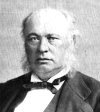 |
|
Schenectady, New York in 1819. He came to
California in 1849 via Cape Horn. He wrote an account of his journey, Seeking the Golden Fleece, the first of several books about
his travels. Stillman was a friend of and partners with Mark Hopkins,
Charles Crocker, and James Flood. He founded the first hospital in
Sacramento and the first medical society in California; was the coroner
of the City and County of San Francisco and a San Quentin physician;
was the personal physician to Governor Leland Stanford and his family;
was one of first medical professors at UCSF; and was a |
botanist and viticulturist who produced some of the earliest wines in California.
In 1880 he retired from medicine and moved to Redlands where he farmed
800 acres. JDB died March 2, 1888 in Redlands." (Quoted from
the website of the San
Anselmo Historical Museum). Stillman was granted a scholarship
to attend Union University in Schenectady, the first non-denominational
college in the United States, and graduated with majors in botany and
biology in 1843. Apparently he received medical training because he became
a physician and surgeon, yet another of the many individuals who found
a nexus between medicine and botany. His book An 1850 Voyage, San
Francisco to Baltimore, By Sea and Land, describes an amazing journey
that involved shipwrecks, rescues at sea, the sinking of canoes on
Lake Nicaragua, an accidental poisoning and events too numerous to
recount here. Upon returning to New York he again took up a medical
practice and the next few years included the death of his first wife,
his remarriage and his travels through Europe with the governor of
California. Soon after returning from Europe, he traveled throughout
Texas considering it as a place to relocate. This was another epic
of adventure he described in Wanderings in the Southwest, which
included many vivid descriptions of flowers, birds, animals, and trees,
and dangerous encounters with hostile indians. Evidently he reconsidered
his earlier thoughts about moving to Texas, because he soon returned
to California, where he lived for the rest of his life. Most of his
time was taken up by medical matters, but he is also recorded as standing
next to Governor Stanford at the Golden Spike ceremony officially
completing the transcontinental railroad. His final years also included
more trips to Europe and around the world, often filled with botanical
observations, a book on horse anatomy, his position as chair of the
incorporation committee for the city of Redlands, and significant
work in developing the California wine industry. Among his six children
were represented the major occupations, one a vice-president of Stanford
University, one a physician, one an attorney and another an engineer
(Photo credit: Geni)
- stinchfield'iae: named for Roxana Judkins (Stinchfield) Ferris (1895-1978),
an early staff member of the
Dudley
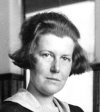 |
|
Herbarium of Stanford University,
author of Native Shrubs of the San Francisco Bay Region (1968), Flowers of the Point Reyes National Seashore (1970), Death
Valley Wildflowers (1983), and co-author with LeRoy Abrams of Flora of the Pacific States, Vol. IV. The following is quoted
from Sara Timby, "The Dudley Herbarium" in Sandstone
and Tile, the journal of the Stanford Historical Society, Vol.
22, No. 4: "Ferris was the mainstay of the herbarium. Her official,
full-time job lasted forty-seven years, but she was a student assistant three additional years, and she continued her |
connection with the herbarium in many capacities after her retirement. John Thomas, her colleague
and staunch admirer, wrote "Although the titular curators came and
went, Roxy ran the place." That is not to say she was always there;
she did a tremendous amount of fieldwork, collecting some 14,000 specimens,
often with many duplicates that were traded with other herbaria. Ferris
received her AB degree from Stanford in 1915 and her AM in the
following year with a thesis on the "bird's beaks," the genus Cordylanthus. Her husband, Gordon Floyd Ferris, was an entomolgist
who studied the scale and sucking insects such as lice and aphids.
They married in 1916, when both started working for Stanford. They
had one daughter, Beth, born in 1917. Roxy's mother lived with them
and cared for Beth. Roxy's professional titles did not come as quickly
as the men around her, but eventually she did become assistant curator,
associate curator, curator, and finally curator emerita. Ferris officially
retired in 1963, and shortly thereafter had a heart attack. But she
kept working at the herbarium until the early seventies and died at
age eighty-three in 1978.
- Sti'pa: from the Greek stupe or stuppeion, "tow, flax, fiber, cordage," for the feathery or plumose inflorescences. The genus Stipa was published by Carl Linnaeus in 1753, and is referred to as feather-grass.
- stipa'ta: from the Latin stipatus, "compressed, surrounded."
- stipita'ta/stipita'tum/stipita'tus: borne on a stipe or stalk.
- stipo'ides: resembling genus Stipa.
- stipula'ceum: having stipules or well-developed stipules, from Latin stipula, diminutive of stipes, "stalk," and -cida, "cut," alluding to the incised stipules.
- stipular'is: having stipules.
- stipulif'era: stipule-bearing.
- stivers'ii: named for Dr. Charles Austin Stivers (c.1837-1888)
of San Francisco, a collector of
California plants. "Probably no two independent workers in botany
would be likely to agree upon the specific limitations of any Californian
species of Lupinus and their various forms with the exception
of one species. That exception is Lupinus stiversi, an annual
of the higher foothills of the Sierra Nevada. With yellow banner and
rose-pink wings it is a most beautiful species which is never mistaken
by even the novice, nor confused with any other member of the genus." (Jepson, 1933)
It was discovered by Charles Austin Stivers, USA,
often cited as an Army Lieutenant, at Summit Meadow on the Mariposa trail to Yosemite in or about the
year 1862, and was named in his honor by Dr. Albert Kellogg (Proc.
Cal. Acad. 2:192,-1862). Of Charles Stivers little is known. He
held the degree of doctor of medicine, and was at one time especially
interested in the study of the marine algae. His name is mentioned
occasionally in the pages of early proceedings of the California Acad.emy of Sciences.
(from Willis Lynn Jepson, Madrono Vol. 2 page 28). David Hollombe provides
the following information: "Stivers was born in New York, probably
New York City or somewhere on Long Island. (His father was Daniel
Albertson Stivers from Matinecock, Long Island and I suspect he may
have been the D.A. Stivers who came to California in 1849 with John
Woodhouse Audubon, John Boardman Trask, etc.) Though Kellogg refers
to Lieutenant Stivers I haven't found his name on any Army records.
He edited California Horticulturist from April through November,
1871. His age was given as 50 in the first newspaper reports of his
death, later changed to 51, and this agrees with the 1880 census and
voting registers. The age given in the 1860 census (17) is probably
an error. (He is listed as female and his initials are reversed.)
He received his MD at Tolland Medical College in San Francisco (later
UCSF Medical School). And from the San Francisco Chronicle Nov. 5, 1888: "Dr. Stivers, who was well known in this city,
died suddenly yesterday morning at his residence on Washington street.
He was Dr. Blach's assistant when the latter was first appointed City
Physician and was also the first Police Surgeon of of the city. During
his regime he established the city receiving hospital."
- stoe'be: there are numerous explanations for the derivation of this epithet, but none are entirely satisfactory. The PlantzAfrica website says that the name of the genus Stoebe is from the Greek stoibe, "stuffing, padding or heap."
It was apparently used for packing wine jars and making brooms and
bedding. Umberto Quattrocchi gives the following, also for the genus Stoebe: "Greek steibein, stibo "to
tread firmly," stoibe "thorny burnet, a species of Poterium," Latin stoebe, is for a plant,
called also pheos (Plinius)." From David Hollombe: "stoibe,
name used by Dioscorides for Poterium spinosum, also meaning
a cushion or pad." Jaeger's Source-book says Greek stoibe, "a padding, a heap." Wiktionary says from Greek steibo, "to tread or stamp." With reference to the taxon Centaurea stoebe (which is the one in the California flora), the website Flora Neomexicana has this: "Greek stoibe, a padding or stuffing, alluding to the use of the plant for packing and for brooms.
- stoechadifo'lia: with leaves like lavender, from Lavandula stoechas or Spanish lavender or French lavender. I have found two etymologies
for the name Stoechades: (1) Stoechas was a Greek name for a plant
in the mint family which grew on a group of islands off the coast
of France now called the Ile de Hyeres where this species apparently
grew; and (2) "The Greeks had named these islands 'Stoechades,'
'the rows,' undoubtedly because for a sailor who enters
the roads they appear to form an alignment. Other archipelagoes in
the Mediterranean bore names thus indicating the position of the islands.
For example, Kikladhes, at Aegean Sea, laid out in a circle, Sporades
(today Dodecanese) because they are scattered." (From a website about the Frioul Islands) The derivation of the term lavender is interesting
as well. "Romans used lavender oils for bathing, cooking, and
scenting the air, and they most likely gave it the Latin root name
(either lavare, 'to wash.' or livendula, 'livid or bluish,' from which we
derive the modern name." (From The
History of Lavender). In 12th to 15th century Middle English,
washerwomen were called 'lavanders' or 'lavenders', and 'to lavender'
meant 'to launder,' and they used the plant which had a pleasant smell
to scent drawers and freshen the clothes.
- stokes'iae: named for Susan Gabriella Stokes (1868-1954), Rocky Mountain naturalist interested in the Polygonaceae genus Eriogonum. She studied at Stanford University under William Russel Dudley. She was a resident of Salt Lake City and taught biology at Salt Lake High School from 1896 to 1904. In her collecting activity she focused almost entirely on Eriogonum and gathered specimens of this genus throughout Utah and in all of the western states except for Montana and Texas. In 1949 Stokes said that she had collected almost every summer since 1896. A botanical associate of Marcus Jones, she was responsible for a monograph of Eriogonum.
- Stokesiel'la/stokes'ii: named for Whitley Stokes (1763-1845), Irish physician and bryologist, and regius professor of
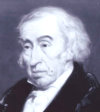 |
|
physics at the University of Dublin. His family was one of the most academically prominent in Ireland. His father, Rev. Gabriel Stokes (1726-1806), was professor of mathematics at Trinity College Dublin, Chancellor of Waterford Cathedral, and an important figure in Irish cultural life. His grandfather, Gabriel Stokes, was a distinguished mathematician and deputy surveyor-general of Ireland. His uncle John was a professor of Greek and a fellow of Trinity College. His son, William Stokes (1804-1878), professor of physics at the University of Dublin, was one of the greatest Irish |
physicians of the 19th century, and his grandson, Whitley Stokes (1830-1909), was a lawyer and Celtic scholar. Whitley Stokes was educated at the Endowed School, Waterford, entered Trinity College, Dublin in 1779 and, having won a scholarship, graduated with a BA in 1783, an MA in 1789, and an MD in 1793. He became a fellow in 1788 and was appointed King’s professor of the practice of medicine in 1793. The following is quoted from a biography entitled William Stokes, his Life and Work written by his son William Stokes and published in 1898: “Whitley Stokes, like his father and uncle, was a scholar and senior fellow of Trinity College, and held a position of great prominence in the scientific, literary, and political circles in the Irish capital towards the end of the last and beginning of the present century. He was a man of pure and lofty aims, singular unselfishness, untiring energy, and capable of such self-devotion as too often frustrates its own object. In the pursuit of means by which he might promote the moral interests and physical resources of his country all else was forgotten. In early life it was his intention to take Holy Orders, but, on obtaining a fellowship in Trinity College, he relinquished that idea, and devoted himself to the study of medicine. About the year 1800 he became professor of the practice of medicine in the Royal College of Surgeons, which chair he held for several years. In the year 1816 … he felt compelled to resign his senior fellowship. His services, however, were not lost to the University, as he was appointed to the Lectureship on Natural History, and ultimately was elected regius professor of Medicine. In early life he became a member of the Society of United Irishmen, in the first months of its existence, but as soon as he found that the object of its associates was not to be confined to effecting reforms by peaceful and constitutional means, he retired from taking any action in their proceedings. This was in 1792. However, it being suspected that his sympathies were still largely with the movement, and the principles advocated by Grattan, Curran, and other Irish patriots and friends, he was cited to appear before the Vice-Chancellor of the University, Lord Clare, with the result that, notwithstanding his previous secession from the society, and before it had become a secret organization, he was suspended from his fellowship for a year.” These actions were taken because he was suspected of being part of the nationalist movement then sweeping Ireland. He was also suspended from teaching for three years. However one of the nationalist movement’s most prominent members, Wolfe Tone, the leader of the 1798 revolution, who had been a fellow student of Whitley Stokes at Trinity College, wrote of him, “With a most excellent and highly cultivated mind he possesses the distinguishing characteristic of the best and most feeling heart, and I am sure that it will not hurt the self-love of any of the friends whose names I have recorded when I say in the full force of the phrase, that I look upon Whitley Stokes as the very best man I have ever known." A website called Library Ireland in an article about Whitley Stokes says: “When the passions of the times had worn themselves out, Stokes regained his former positions. In 1805 he was made a senior fellow; in 1816 he was appointed lecturer of natural history and in 1830 he became regius professor of physics to the university, which appointment he held until 1842 when he was succeeded by his son, William (1804-78). Whitley was engaged in many activities in addition to his university work. As a physician he had a large practice and much distinguished himself by his treatment of fever during the severe epidemics of 1817 and 1827 and he was instrumental in founding the College Botanical Gardens and in establishing the Zoological Gardens in Dublin.” His wife Mary Anne Picknoll predeceased him in 1844 and he died at his home in Dublin. The genus Stokesiella was published by Ernst Johann Lemmermann in 1908.
- stolonif'era/stolonif'erum: bearing stolons or runners.
- stonea'na: named for Jennifer Susan Stone (1949-2000). An 'In Memorium'
essay in Fremontia provided the following: "Jennifer Stone, plant
ecologist for the U. S. Navy, Navy Facility Engineering Command (NAVFAC),
Engineering Field Division Southwest, San Diego, passed away on April
3, 2000, after a long battle with cancer. Jennifer was a vital member
of the San Diego chapter of CNPS, serving as president in 1999 and
contributing energetically to that chapter's activities, particularly
the plant sales. Some of Jennifer's projects as a Naval plant ecologist
included work on San Clemente Island and with UCLA on sludge remediation,
wetland restoration, and wetland monitoring."
- stramin'eum/stram'ineus: straw-colored, from Latin stramen, "straw," and stramineus, "made of straw."
- straminifor'mis: like straw.
- stramon'ium: derivation uncertain. One source says "spiky-fruited," and a name used by Theophrastus for the
thorn-apple. Gledhill and Wiktionary say possibly from the Tartar turman, "medicine for horses." The website of the Global Biodiversity Information Facility provides this: "The origin of Neo-Latin stramonium is unknown; the name Stramonia was used in the 17th century for various Datura species. There is some evidence that Stramonium is originally from the Greek words for 'nightshade' and 'mad.' It is called umathai in Tamil. In the United States the plant is called 'jimsonweed,' or more rarely 'Jamestown weed' deriving from the town of Jamestown, Virginia, where English soldiers consumed it while attempting to suppress Bacon's Rebellion. They spent 11 days in altered mental states." The early colonists also suffered from it not knowing of its dangerous nature. The Greeks were aware of its hallucinogenic, hypnotic and potentially lethal effects. The drug stramonium was in the British pharmacopaeia for centuries and had an honorable place there in the treatment of asthma right up to the end of the Second World War; it is still used in homeopathic medicine.
Wikipedia says "The origin of Neo-Latin stramonium is unknown; the name Stramonia was used in the 17th century for various Datura species. There is some evidence that Stramonium is originally from Greek στρύχνον, 'nightshade' and μανικόν, 'which makes mad'."
- stratio'tes: from the Greek stratiotes for "soldier," applied to this
aquatic herb on account of its sword-shaped leaves.
- Strelit'zia: named for Charlotte Sophia of Mecklenburg-Strelitz (1744-1818) who married King George III in 1761 and
 |
|
served as Queen of Great Britain and Ireland until 1801 when the two kingdoms were joined and she became Queen of the United Kingdom and Ireland until her death. When her husband was made King of Hanover in 1814, she also became Queen consort of Hanover. She was born in Mecklenburg-Strelitz, Prussia, the youngest daughter of Duke Charles Louis Frederick of Mecklenburg. Her education was meager, receiving some rudimentary instruction in botany, natural history and language from tutors, but was mostly focused on household management and on |
religion. She was engaged to the future king at the age of 17, and was married later that same year, 1761. Her command of the English language was nonexistent at the time but she quickly mastered it although continued to speak with a German accent. What is perhaps best remembered about the reign of King George III was his developing insanity that obviously had a major effect on the Queen. She was a patroness of the arts and an amateur botanist who helped expand Kew Gardens. Her interest in botany led to the South African flower, the Bird of Paradise, being named Strelitzia reginae in her honor. She and her husband were both music connoisseurs and enjoyed particularly the music of Handel, Mozart and Bach. Two of her 15 children became King, George IV and William IV. She also was the mother of Ernest Augustus, King of Hanover and Charlotte, Queen of Württemberg. The genus Strelitzia was published in 1789 by William Aiton. (Photo credit: Find-a-Grave)
- Streptanthel'la: a diminutive form of Streptanthus. The genus Streptanthella was published by Per Axel Rydberg in 1917.
- streptanthifo'lius: with leaves like Streptanthus.
- Streptan'thus: from the Greek streptas,
"twisted," and anthos, "flower." The genus Streptanthus was published by Thomas Nuttall in 1825.
- streptocar'pa: with twisted fruit.
- Strepto'pus: from the Greek streptos, "twisted," and pous,
"foot," alluding to the twisted stalks of the flowers. The genus Streptopus was published by André Michaux in 1803.
- stria'ta/stria'tus: striped, lined, from Latin stria, "furrow."
- stric'ta/stric'tum/stric'tus: Stearn says "upright, erect," while Gledhill says "erect, close, stiff," from stringo and stringere, "to bind, press together, draw tight, compress, press together." Carex stricta is called upright sedge.
- strigata: having transverse bands of color, striped, from Latin strigatus, "striped."
- strigo'sa/strigo'sus: strigose, that is, covered
with straight, flat-lying hairs, from Latin strigosa, "covered in straight, flat lying hairs" and stria, "appressed stiff bristles or hairs."
- Strigosel'la: with bristly hairs. The genus Strigosella was published by Pierre Edmond Boissier in 1854.
- strigulo'sa: minutely strigose.
- strobila'cea: of or pertaining to a cone,
cone-like.
- strobili'na: from the Greek strobilos, "anything twisted,
a cone."
- Stroe'mia: named for Hans Strøm (1726-1797), a well-known Norwegian minister, educator, zoologist and naturalist.
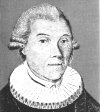 |
|
He was born at Borgund in Møre og Romsdal, Norway, the son of a clergyman. Many other relatives of his on both sides of his family were also ministers. He attended the Bergen Cathedral School, was a student at the University of Gottingen in Germany, was educated as a Lutheran clergyman, and in 1745 took a theological degree at the University of Copenhagen. He worked as a chaplain in Borgund from 1750 to 1764, and in 1764 he became a parish priest in Volda, serving until 1779, then a vicar in Eiker where he served for eighteen years. He established his scientific |
reputation when he published the results of his research as Physisk og Oeconomisk Beskrivelse over Fogderiet Søndmør I–II (Copenhagen, 1762–1766). He was the first Norwegian who gave species descriptions for Norwegian animals and was the co-founder with Gerhard Schoning, the historian, and Johan Ernst Gunnerus, Bishop of Trondheim of the Royal Norwegian Society of Sciences and Letters in 1760. In 1779, Strøm was elected a foreign member of the Royal Swedish Academy of Sciences. He was also elected as a member of a number of science academies in Norway, Denmark and Germany. He studied the topography and plant life of the coast region where he spent most of his life and produced a series of excellent works that were highly praised by Carl Linnaeus. He died at Hokksund in Øvre Eiker in Buskerud. The genus Stroemia was published by Martin Vahl in 1790.
- Strombocar'pa: the website PhytoKeys says this epithet comes from Strombo-, (Italian for "conch") and -carpa, (Greek for "fruit"), referring to the resemblance of the fruits to the spiral shells of tropical marine molluscs. The Jepson Herbarium says Latin for "spiral twisted fruit."
- strombulif'era: from the Greek strombos and the Latin strombus,
"a turban, a top, also a kind of spiral snail," referring
to the tightly coiled fruit.
- strumar'ium: of or pertaining to tumors
or ulcers.
- strumo'sa: having tubercles, or cushion-like swellings, from struma, "scrophulous tumors" and strumosus, "swollen."
- Struthiop'teris: from Greek struthos, "ostrich," and Latin pteris, "fern." The genus Struthiopteris was published in 1760 by Joannes ntonius Scopoli.
- strutz'iae: named for Aline Sawhill Strutz (Mrs. Louis Strutz) (1899-1995), a pioneer Alaskan, expert gardener,
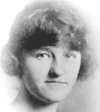 |
|
amateur botanist and authority on Alaska’s wildflowers. She was born on a ranch near Nimrod, Montana, attended a one-room school through eighth grade, and then moved to Missoula for high school and business college. She was working as a stenographer for the US Forest Service in Thompson Falls, Montana, and then was a division storekeeper for the Northern Pacific Railroad in Parkwater, Washington, when she met her future husband, Louis Strutz, and followed him to Anchorage when he was transferred there in the Army, marrying in 1920. In 1924 they moved into a |
house that she would live in for 71 years. Aline Strutz led a subsistence lifestyle in assisting to provide for her large family. This description was given in the Strutz family file in the Atwood Resource Center, Anchorage Museum at Rasmuson Center: “ . . . for the first years life went on in a two-bedroom home without electricity or running water and cooking on a wood stove. It was truly subsistence living. She learned how to mend salmon nets; in the spring she strung them between the three trees on the front lawn, and mended them. Each tide found the children on the beach picking the salmon from the nets and carrying them up the hill where Aline cleaned and canned or readied the salmon for the smokehouse. Many quarts of salmon were consumed each year by this large family. Aline also traded the surplus from the vegetable garden to the local grocer for canned and dried fruits.” She was active throughout her life in the Anchorage Garden Club and was a life member of the National Council of State Garden Clubs. She belonged to a number of other societies. She and her husband were also founding members of the Cook Inlet Historical Society. The Anchorage Daily News in 1995 said: “Her yard was featured for many years on the local home and garden tours. As an amateur botanist, she was considered an authority on Alaska wild flowers by professionals in many parts of the world, and she regularly corresponded and traded seeds with her fellow botanists in Canada, South America, Austria, Switzerland, New Zealand, Africa, Sweden, Czechoslovakia, England, and Scotland. She also traveled extensively into remote regions of Alaska to collect and photograph new flowers. She wrote several articles for gardening journals, and many of her pictures of Alaska wild flowers were printed in Alaska-Yukon Wild Flower Guide and Alaska's Wild Berry Guide and Cookbook.” The website Alaska History says: “She visited many areas to find wild plants which she transplanted in her yard. She eventually collected over two-thousand specimens and wrote articles for national and international gardening journals about Alaska’s wild flowers and wild berries. She also contributed to rock garden publications and other bulletins in the United States as well as in Britain. As a member of the Anchorage Garden Club, she participated in its flower shows, winning numerous honors. In addition to botany, she judged flower shows, furnished flowers for flower-arranging workshops, and preserved vegetables and fruits to share with friends. She went bowling and dancing, and continued her other hobbies into her late eighties.” She died in Anchorage at the age of 96.
- Stucken'ia: named for the German teacher, amateur botanist and entomologist Wilhelm Adolf Stucken (1860-1901).
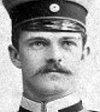 |
|
Not a lot available on this individual, but David Hollombe sent me the following: "All I have on Stucken is that he was born in Bremen, Germany and died in Zellerfeld and that his specimens are at the Ubersee Museum, Bremen, and that some of his plants were collected in Australia and some (30) in America." He taught Latin, Greek and German at a school in Bremen. He was the headmaster of the Gottingen Gymnasium and was associated with the Natural Science Association of Bremen. JSTOR lists him as a plant collector in the United States and Australia. He was married |
and had one son. The genus Stuckenia was published by the German entomologist Carl Julius Bernhard Börner in 1912. (Photo credit: Geni)
- stuebel'ii: named for Moritz Alfons (Alfonso, Alphons, Alphonse) Stübel (1835-1904), a German geologist and
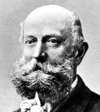 |
|
volcanologist born in Leipzig. His mother died when he was only 1, and his father in 1849. He and his two sisters were educated in Dresden by their uncle City Judge Carl Julius Stübel and in 1855 he studied chemistry and mineralogy at the University of Leipzig. He discontinued his studies due to health concerns and traveled south to Egypt and the regions of the Blue Nile and Nubian Desert, returning through Rome and Naples where he made his first volcanological researches. In 1859 and 1860 he continued his studies of mineralogy, chemistry and physics in Heidelberg, where he also |
obtained his doctorate, finishing his studies in Berlin. In 1862 Stübel visited Scotland as well as the Orkney and Shetland Islands. He also visited Morocco, Madeira, the Cape Verde Islands, Portugal and Spain, and the Canary Islands, carrying out more volcano investigations. He met Wilhelm Reiss in 1865 and with him in 1866 went to the island of Santorini to observe a volcanic eruption. A trip originally intended to focus on Hawaii became a multi-year stay in South America, where they did volcanology and archeology in the Andes, Columbia, Ecuador, Peru, Brazil, Uruguay, Argentina, Chile and Bolivia. Reiss had left the previous year and Stübel traveled through Central America to San Francisco, then crossed the United States and returned to Europe in 1877, settling in Dresden. In South America he also made astronomical measurements and performed meteorological, ethnographical, and zoological research. Scientific material collected in South America was later preserved at the Museum of Comparative Cultures in Leipzig. In addition, Stübel took numerous photographs and created sketches of the places he visited. Many of the butterflies collected by Stübel were new species. They were described by the German entomologists Gustav Weymer and Peter Maassen. Stübel also made a lesser known contribution to the study of the Middle East. In the years 1858, 1882 and 1890 he traveled mainly in Syria, Lebanon, Palestine, and Egypt. He collected about 600 large-size photographs on these journeys and on other occasions. This collection came via his nephew Bruno Stübel to Jena University. They form the core of the Alphons-Stübel Collection of Early Photographs of the Middle East 1850-1890. In 1878 he became a member of the Leopoldina. He was a corresponding member of the Thuringian-Saxon Association of Geography. In later years Stübel worked closely with Theodor Wolf, whom he had met in Ecuador. Both were devoted to volcanological issues. Stübel died in Dresden in 1904.
- sturm'ii: named for Jacob Sturm (1771-1848), a German engraver, botanical artist and naturalist. He was born and
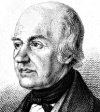 |
|
lived in Nuremberg. His father was the engraver Johann Georg Sturm and Jacob received training in drawing and copperplate engraving from him. Jacob Sturm was the most famous engraver of natural history publications in Germany at the end of the eighteenth and beginning of the nineteenth century, and was a leading engraver for scientific botanical and entomological publications. Sturm became a celebrated insect collector and founded the Nuremberg Society for Natural History. His entomological and botanical plates are very accurately drawn and show minute details and enjoyed |
a great popularity among naturalists. As most of his works were published in a small format, they could be purchased by a larger public and they were very popular. During this period, Nuremberg was the center of natural history book production in Germany. Jacob Sturm was a major engraver for Deuschlands Flora during the 1800s.
- Stut'zia: named for Howard Coombs Stutz (1918-2010), a professor of genetics at Brigham Young University who
 |
|
studied plants in North America, Europe, the Middle East and Australia, published more than 80 papers and wrote a book on science and evolution entitled Let the Earth Bring Forth: Evolution and Scripture. He was born in Cardston, Alberta, Canada, and attended Brigham Young University, graduating with an undergraduate degree and a master’s degree. He was awarded a PhD in genetics from the University of California, Berkeley. He was an instructor at BYU for almost 40 years, and he and his wife were married for 70 years. He served in various church callings from bishop, to high |
councilor, to stake patriarch. He was a professor at BYU for over 40 years. His primary areas of research were on the history of the cultivation of crops such as rye, and on desert shrubs. He is most well known for his research on Atriplex. He was instrumental in arranging with the US Forest Service to establish a formal research laboratory adjacent to BYU for the study of desert shrubs of the western United States. For many years he worked with Utah International in New Mexico providing research and resources for strip mining reclamation. In 1982, Dr. Stutz and his wife, Mildred, established a perpetual scholarship award at BYU for graduate students' studies of desert shrubs. He reluctantly retired from teaching at the age of sixty-five but continued his research well into his eighties. The genus Stutzia was published by Elizabeth H. Zacharias in 2010. (Photo credit: Find-a-Grave)
- stylesia'num: named for John Styles (c.1799-1855). According to David Hollombe, "Dr. John Styles was probably born in Britain. In 1830, in Valparaiso, Chile, he married a daughter of the American consul, Harriet Styles. He arrived in Philadelphia in 1837. After that he spent some time in Havana &/or Sagua la Grande, returning to New York at least twice, in 1846 and 1851." He became a corresponding member of the Academy of Natural Sciences of Philadelphia in 1834, and he and his wife had two children. He died at Staten Island, Richmond County, New York, USA, being buried in Manhattan.
- Stylocli'ne: from the Greek stylos for "column, pillar or pole" and kline, "a bed," alluding to narrowly cylindric receptacles of the type species. The genus Stylocline was published by Thomas Nuttall in 1840.
- Stylome'con: from the Greek stylus,
"a style," and mekon, "poppy," describing
the shape of the style. The genus Stylomecon was published by George Taylor in 1930.
- stylo'sa: with a prominent or well-developed style.
- styraciflu'a: flowing with resin or gum, see following entry.
- Sty'rax: the classical Greek name used by Theophrastus
and derived from a Semitic name for these resin-producing plants from
which was collected the gum storax. The genus Styrax was published by Carl Linnaeus in 1753.
- Suae'da: from an Arabic name suwed-mullah of antiquity, possibly applied to Suaeda baccata. FNA says from "Arabic suaed, black, Arabic name for Suaeda vera." Wikipedia says "the name Suaeda comes from an oral (non-literary) Arabic name for the Suaeda vera species transliterated as suaed, sawād or suēd, and it was assigned as the genus name by the 18th century taxonomist Pehr Forsskål during his visit to the Red Sea area in the early 1760s. The genus Suaeda was published by Pehr Forsskål in 1776.
- sua've: sweet, from Latin suavis, "agreeable."
- suaveo'lens: sweetly-smelling.
- sub-: below, under, almost, approaching, somewhat, rather (used
before words beginning with most consonants, but see suc-, suf-, sug-).
- subacau'lis: without much of a stem.
- subalpin'um: inhabiting mountain ranges below the alpine level.
- subar'idum: from sub- in compound words meaning
"somewhat, almost, slightly, partially" and aridum meaning
"growing in dry places."
- subbiflor'um: from the roots sub- for 'under, below, somewhat, almost, rather, partially,' and -biflorum for 'two-flowered'.
- subbractea'ta: not quite bracted, bearing structures that approach
being bracts.
- subcarina'ta: having the beginnings of a keel.
- subconges'ta: becoming crowded.
- subconvex'a: the sub- prefix is used
before words beginning with most consonants, and means "below, under, almost, approaching, somewhat, rather," so subconvexa would mean "somewhat convex." The species Quercus X subconvexa is a hybrid of parents Q. durata and most likely Q. garryana. Garryana has flat leaves, durata has strongly convex leaves, and X subconvexa has slightly convex, i.e. subconvex, leaves.
- subcorda'ta/subcorda'tum: rather heart-shaped.
- suberec'ta: not quite erect.
- subero'sa: corky-textured, from New Latin suberosus, from Latin suber, "cork oak, cork," and -osus, "-ose."
- subfus'ca: darkish or brownish, not quite brownish.
- subglab'ra: not quite glabrous.
- subglobo'sum: not quite but approaching globose, somewhat globe-shaped or
spherical.
- subinclu'sa: from sub-, "almost,
approaching," and inclusa, from Latin inclusus, "confined,
shut up, included," therefore meaning almost included,
and referring to the anthers which in this species are almost included
within the corolla.
- sublae'vis: not quite smooth.
- subnig'ricans: approaching a color of blackish.
- subnu'da: from the prefix sub-, "somewhat, almost, partially"
and nudus, "naked, uncovered."
- subova'tum: somewhat ovate.
- subpinnatifi'da: somewhat pinnately cut or cleft.
- subpinna'tus: somewhat pinnate.
- subrig'idus: somewhat but not quite rigid.
- subro'seum: not quite rosy-colored.
- subsal'inum: growing in somewhat saline places.
- subscapo'sum: somewhat or becoming scapose.
- subses'sile: somewhat sessile.
- subspica'ta: somewhat (approaching being)
spiked.
- subspino'sa: somewhat spinose.
- subtermina'le/subtermina'lis: the prefix sub- in compound
words signifies somewhat, almost, rather, slightly, partially etc.,
and terminalis means terminal, relating to boundaries in some way,
and since this species lives at the uppermost boundary of the salt
marsh, that may be why it has this name.
- subterran'eum: underground.
- Subular'ia: from the Latin subula, "an awl or small weapon,"
from the shape of some leaves. The genus Subularia was published by Carl Linnaeus in 1753.
- subula'ta/subula'tum/subula'tus:
awl-shaped, from the Latin subulatus meaning awl or needle shaped.
- subuliflor'a: with flowers shaped like awls.
- subulig'era: I had thought this was possibly from uligo or uliginis, "moisture, marshiness " and the sub-
prefix meaning "almost, rather, somewhat." Such a meaning
would fit the habitat for this taxon as wet places. But David Hollombe
says the derivation is from subula, "awl," and gero,
"to bear, to carry," and this is in accord with the Jepson
Manual's common name which is 'awl-leaved navarretia.' He further
provided the information that Greene's description of Navarretia
subuligera includes the following: "Leaves pinnately parted,
the segments subulate [awl-shaped] and rigid."
- subumbella'ta: somewhat umbelled.
- subvesti'tus: from the prefix sub- in compound words used
to indicate "somewhat, almost, rather, slightly, partially"
and vestitus, "covered, clothed, usually with hairs."
- subvillo'sa: with rather soft hairs, somewhat villous.
- subvisco'sa/subvisco'sus: slightly sticky
or viscous.
- suc-: see sub- (used for words beginning with c).
- succi'sa: appearing bitten or broken off. Succisa is a fairly common specific epithet and also a genus called devil's-bit scabious which is not in California, and about which Stearn says "From Latin succido, cut off below, with reference to the truncate end of the rhizome, looking as if bitten off by the Devil."
- succulen'ta/succulen'tus: thick and fleshy,
juicy, from the roots succus, "juice," and -ulentus,
a suffix indicating an abundance of.
- su'dans: uncertain but appears to mean "sweating."
- suf-: see sub- . (used for words beginning with f).
- suffla'tus: somewhat or rather inflated.
- suffoca'tum: from Latin suffocatus, past participle of suffocare, "to choke." The species Trifolium suffocatum is called the suffocated or suffocating clover, a name it gets from the dense mats of foliage it forms on the ground.
- suffrutes'cens: somewhat or rather woody at the base.
- suffrutico'sa/suffrutico'sus: very low,
barely woody and shrub-like, somewhat shrubby.
- suffusus: tinged. Wiktionary says suffusus is the perfect passive participle of suffundo, “suffuse; blush, ” but Etymonline says "Latin suffusus, past participle of suffundere "to overspread, pour beneath, pour upon," from sub, "under," and fundere, "to pour." Gledhill says "tinged, colored, blushed," of uncertain application.
- sug-: see sub- (used before words beginning with g).
- sukatschew'ii: named for Vladimir Nikolayevich Sukachev (Sukaczev) (1880-1967), a Russian geobotanist, engineer,
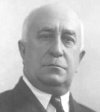 |
|
forester, geographer, and member of the USSR Academy of Sciences. He was born in Aleksan-drovka, Russia, and attended the Imperial Forestry Institute in Saint Petersburg, where he studied under Gavriil Ivanovich Tanfilyev and Vasily Dokuchaev, graduating in 1902 and remaining several years with the institute working at the vascular plant herbarium of the botanical museum. During this period he conducted fieldwork in Baikal. He apparently served and fought for a time in the Red Army around 1918. In 1919 Sukachev founded the department of dendrology and systematics of |
plants at the Imperial Forestry Institute, which he chaired until 1941. He was a professor at the Geographic Institute (1919-1925), the Botanical Garden (1924-1933) and at St. Petersburg University (1925-1941). From 1941 to 1943, he managed the department of the biological Ssciences at the Ural Forestry Institute, in Sverdlovsk. In 1944, Sukachev organized the Forestry Institute of the USSR Academy of Sciences (now the Institute of Forest and Wood of Siberian Department of the Academy of Sciences of the USSR, Krasnoyarsk), which he led up to 1959. Sukachev also led the Laboratory of Forestry USSR Academy of Sciences (1959) and the Laboratory of Biogeocenology (more or less the Russian equivalent of ecology) with the Botanical Institute of the AS USSR (1965). In 1965 he was made a Hero of Socialist Labor. Sukachev was president of the Moscow Naturalists Society from 1955 to 1967. He was a founding member of the Russian Botanical Society (1915), and was from 1946 to 1963 its president (from 1964 honorary president). He led the 7th International Botanical Congress in Stockholm in 1950 and edited both the Botanicheskiy Zhurnal and the Bulletin of the Moscow Society of Naturalists. The Sukachev Institute of Forestry, part of the Russian Academy of Sciences, in Moscow, is named after him. His most important contribution to botany was almost certainly Fundamentals of Forest Biogeocoenology, published posthumously in 1968. This work focused on ecosystems with an emphasis on managed forests, describing patterns of change, although he rejected the concept of a fixed climax community. Among his many interests were dendrology, plant systematics, experimental natural selection, geobotany, grassland and swamp environments, and paleobotany and stratigraphy. Sukachev's forward-looking views came into conflict twice with the Lamarckian views of T.D. Lysenko, first, during the Stalin years, and later when Premier Khrushchev took Lysenko's side in the late 1950s as the latter came under increasing criticism. Sukachev was demoted and his influence suppressed in these later years of his life. He died in Moscow in 1967.
- Suksdorf'ia/suksdorfia'na/suksdorf'ii: named for Wilhelm Nikolaus Suksdorf
(1850-1932), a German born near Kiel
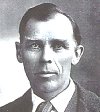 |
|
who emigrated with his family
to Iowa at the age of 8 and began his interest in botany there, continuing
it in California where he later moved and began studies in a science/agriculture
course at the University of California in 1876. The summer vacation
of the year before he had begun serious collecting of Washington state
plants which he focused on for the remainder of his life. He corresponded
with Harvard's Asa Gray because the flora of Washington was not well-known
or identified, and for a brief period, 1886-1888, became Gray's assistant.
A series of physical and |
mental problems with which he was to be plagued throughout his life conspired to end this position. He was not very
well known during much of his career, in part because of his preference
for writing and publishing in the German language, so many of his
articles appeared either in German and Austrian periodicals, or in
obscure American journals which would carry German-language articles.
Much of his collecting was done near his home, which was in the Columbia
River region of Washington, but because he lived where he did, he
was exposed to a wide variety of flora. He did however make some collecting
trips to the Spokane area of Washington, also to parts of Oregon and
Idaho that are near to Washington, to one location in Montana, and
finally he made one major collecting trip to California in 1913. It
was often difficult for later botanists to locate many of his collecting
sites, because he had a habit of giving them German or highly romanticized
names in his notes that did not correspond to any English language
maps. He also used a shorthand system of symbols and abbreviations
that he didn't bother to explain, which further compounded the problem.
But thanks to the herculean labors of graduate student William Weber,
who matched the symbols in his notebooks with those on plant collection
sheets, and also produced a complete itinerary of all Suksdorf's collecting
trips over 57 years, thereby revealing the locations of virtually
all his sites. Suksdorf corresponded with dozens of the country's
most important botanists, collected innumerable plant species, pressing,
identifying and mounting some 150,000 specimens over his lifetime.
In the 1920s he was a special fellow at the herbarium of Washington
State University for two winters. He had a preference for field botany
over laboratory botany, and he tended to be a splitter of species.
He had little regard for the study of plants that took place away
from the field, but nevertheless he made a great contribution to the
knowledge of western botany. His specimen sheets reside in many of
the world's major herbaria, and some 70 species, sub-species and varieties,
plus one genus, bear his name. It is generally accepted that he had
encountered every species that existed in his area of study. He died
in a freak railroad accident near his home in 1932. The genus Suksdorfia was published by Asa Gray in 1880. (Photo credit: Find-a-Grave)
- sul'ca/sulca'ta/sulca'tum: furrowed, from Latin sulcus, "furrow."
- sulfur'ea: see sulphurea below.
- sullivant'ii: named for William Starling Sullivant (1803-1873), an early American botanist recognized as the foremost
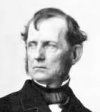 |
|
authority on bryophytes in the United States. He was born in Franklinton, Ohio, which eventually became part of Columbus. His initial education took place in Kentucky, then he spent a year studying at Ohio University when it first opened in Athens, and later transferred to Yale, receiving a bachelor's degree in 1823. His father’s death, however, forced him to abandon an academic career at this time in order to look after the family estate and he began a career as a surveyor and engineer. Much of the following was taken from Wikipedia. He became a surveyor and civil engineer and |
successfully invested in mills, stone quarries, canals and other endeavors. He became interested in botany around 1834, influenced in part by his second wife, Eliza Griscom Wheeler. Initially he was interested in flowering plants and in 1840 published A Catalogue of Plants, Native and Naturalized, in the Vicinity of Columbus, Ohio. Sullivant collected plants throughout the Ohio region and built up a large herbarium with an emphasis on grasses and sedges. He identified and published several new plant species. He became acquainted with other botanists in America, notably Asa Gray and John Torrey. Their support encouraged Sullivant to continue his botanical studies and he turned his focus to mosses and liverworts. In 1843 Sullivant traveled with Asa Gray through the Allegheny Mountains collecting mosses. He presented his findings in a bound two-volume folio, Musci Alleghaniensis (1845, 1846), containing dried specimens of the mosses he had collected along with accompanying text in Latin for each species. He also authored the sections on mosses and liverworts in Gray's Manual of the Botany of the Northern United States (1848). Sullivant's contribution was later published separately under the title, The Musci and Hepaticae of the United States, east of the Mississippi River (1856). In 1864 Sullivant published his most important work, Icones Muscorum, containing 129 illustrations and descriptions of the mosses indigenous to eastern North America. The breadth of this work and the excellent illustrations cemented Sulivant's reputation as the pre-eminent American bryologist of his time. In 1873 he contracted pneumonia and died on April 30, 1873. He had been working on a supplement to Icones Muscorum which was completed in 1874 by his colleagues, Leo Lesquereux. Lesquereux and Thomas P. James also completed his Manual of Mosses of North America in 1884. During his career Sullivant had named and described 270 species of bryophytes and had gained worldwide recognition as the preeminent authority on North America mosses and related plants. He built an herbarium of some 18,000 moss specimens which were donated to Harvard University. Though his own collecting expeditions were limited to the United States, he received many plant specimens from Cuba, Venezuela, and the North and South Pacific. The Sullivant Moss Society was named in his honor and later became known as the American Bryological and Lichenological Society. He was awarded an honorary LLD from Gambier College, Ohio. He was also honored by the publication of the genus name Sullivantia by Asa Gray and John Torrey. He married three times: Jane Marshall (niece of Chief Justice John Marshall) in 1824, Eliza Griscom Wheeler in 1834, and Caroline Eudora Sutton in 1851. He had thirteen children with his three wives. He died of pneumonia in 1873 in Ohio. The genus Sullivantia was published by Asa Gray and John Torrey in 1842. Commonly called cool-wort, Sullivantia is a small genus of 3-4 species in the Saxifragaceae family all native to the United States.
- sulphur'ea/sulphur'eus: sulpher-yellow, from the Latin sulphureus, "sulphur," on account of the yellow color.
- sumatren'sis: of or referring to Sumatra.
- super-: above.
- super'ba/super'bus: superb.
- supi'na: prostrate.
- supinifor'mis: having a prostrate form.
- sup'plex: humble.
- supra-: above, over.
- susquehan'ae: referring to the Susquehanna River in the Mid-Atlantic region of the United States. Wikipedia provides this regarding the origin of the river's name: "Susquehanna may come from the Lenape (Delaware) word siskëwahane meaning "Muddy River". Alternatively, it may come from the Len'api term Sisa'we'hak'hanna, which means "Oyster River". Oyster beds were widespread in the bay near the mouth of the river, which the Lenape farmed. They left oyster shell middens at their villages. A third account translates "Susquehanna" from the Susquehannock (an Iroquoian) language as "the stream that falls toward the south" or "long-crooked-river." The Lenape were an Algonquian speaking peoples who had communities ranging from coastal Connecticut through New York and Long Island, and further south and west into Pennsylvannia, and New Jersey and Delaware in the mid-Atlantic area.
- svenon'is: named for Sven Berggren (1837-1917), a Swedish botanist, explorer and university professor who studied
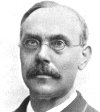 |
|
mosses, liverworts and algae in particular. He was born in Skane and died in Lund. He was a professor at Uppsala University from 1878 to 1883 and then at Lund University from 1883 until his retirement in 1902. “He was elected a member of the Royal Swedish Academy of Sciences in 1880. He collected plants on a number of journeys to then little-known areas of the world, e.g. Svalbard [Spitzbergen] in 1868, Greenland in 1870 (both times with Nordenskiöld's expedition) and, in 1873, New Zealand, Australia, Hawaii and California. He made particularly novel collections and descrip- |
tions of bryophytes and to less extent vascular plants, algae and fungi. His collections are kept at Lund University.” (from Wikipedia) He was the author of On New Zealand Hepaticae (1898) and several other works.
- sventen'ii: named for Eric Ragnor Sventenius (1910-1973), a Hispano-Swedish botanist born Erik Ragnar Svensson in
 |
|
the small town of Skirö, Vetlanda, in Smaland, Sweden. His early education took place in Sweden. He studied and trained professionally as a botanist in various universities across Europe, and then was apprenticed at the Marimurta Botanical Garden in Blanes, Spain, which had been founded in 1920 by the German Karl Faust and had become the most important botanical garden in Catalonia. While in Barcelona, he befriended the Abbot of Montserrat, like him a great fan of botany. He traveled to the Canary Islands first in 1931, and then at some point moved to Barcelona where he |
took charge of the Swedish-Catalan Colony, serving as superintendent. He also served as the director of the newly-established botanical garden there until he was fired by Faust in 1940. Poor, homeless and with Europe at war, he could not risk return to Sweden but instead withdrew to the monastery Montserrat near Barcelona. Here he studied Latin, became good friends with the monk Adeodato F. Marcet, and organized the monastery herbarium and garden. In 1942, he changed his name from Erik Svensson to Eric Sventenius and later was offered a botanist's position at the Jardín de Aclimatación de la Orotava on Tenerife. By 1952 he was working for the botanical garden of the island of Tenerife in a special position under the Ministry of Agriculture. He studied and cataloged unclassified Canarian species. Sventenius proposed creating a botanical garden dedicated to Canarian flora, continuing the work begun by the great José de Viera y Clavijo two centuries before. At Gran Canaria, he founded Jardín Botánico Canario Viera y Clavijo in 1952 at Tafira Alta, about 7 km southwest of Las Palmas, which opened its doors to the public in 1959, working there as the garden's director until his death. During all the time that Sventenius was in the islands he was a tireless researcher touring every inch of the islands looking for new species of the rich Canarian flora not yet classified, dusting the studies of other botanists who in previous times had done work on the Canarian flora and been forgotten, welcoming teams of scientists from around the world who came to their call with complete portable laboratories for the study of the Canarian flora. He wrote 23 papers, and named over one hundred taxa. He was acidentally run over by a driver while waiting to be picked up outside the garden. His grave is in the garden. He was also honored with the genus name Sventenia. (Photo credit: Rincones del Atlánticos)
- swain'iae: named for Edith Vada Sprague Swain (1889-1961), the wife of Alanson Swain, superintendent of the Santa Cruz Island Company, 1916-1919. She was born in Nebraska and was interested in botany. In 1919 she collected a number of herbarium specimens on Santa Cruz Island, many of which are in the California Academy of Sciences herbarium. Her collection of island bigpod ceanothus, Ceonothus insularis on Santa Cruz Island in the spring of 1919 is referred to by Howard McMinn in An Illustrated Manuel of California Shrubs (1939). Fruiting specimens were also collected by her on July 17, 1917. She died in Claremont.
- Swainson'a: named for Isaac Swainson (1746-1812), a woolen draper, botanist and purveyor of questionable medicines. Most of the following is from Wikipedia and the website of the Twickenham Museum in England. He was born in Lancashire and went as a young man to London to seek his fortune. After working as a woolen draper he served as an assistant to a Dr. Mercier in Frith Street, Soho. Later, he purchased from Dr. Mercier the recipe of a patent medicine called "Velnos' Vegetable Syrup." This medicine became well-known, and was extravagantly puffed in Bannantine's collection of squibs called 'New Joe Miller' (1800-1801). By this he reputedly made as much as £5,000 a year from the sales of its preparation. In addition to curing various venereal diseases, including “the pox” and the “French disease,” it was claimed to cure leprosy, gout, scrophula, dropsy, small pox, consumption, tape worms, cancer, scurvy, and diarrhea. From the profits for the sale of this remedy, because of which he has been called a radical quack, shortly after 1788 he took a lease of the Heath Lane Lodge estate in Twickenham. The extensive land at Heath Lane Lodge enabled Swainson to realise his ambition to create a botanical garden. The garden was first laid out under the direction of Daniel Grimwood, nurseryman, of Kensington and later managed by Arthur Biggs. He apparently also studied orthodox medicine, taking his MD in 1785, although there is no record of his subsequent election to the Royal College of Physicians. He was, however, best known as a learned and indefatigable botanist, especially in medical botany. He was a relative of William John Swainson, the English ornithologist, malacologist, conchologist, entomologist and artist. He died in the Soho district, City of Westminster. The genus Swainsona was published by Richard Anthony Salisbury in 1806. (Photo credit: Twickenham Museum)
- Swallen'ia: named for American agrostologist
and taxonomist Jason Richard Swallen (1903-1991). "Jason was
born
 |
|
May 1, 1903, in Alliance, Ohio. He earned a BA from Ohio Wesleyan
University in 1924 and an MS from Kansas State Agricultural College
in 1925, doing a thesis on the Ranales of Kansas. He spent two summers
at the Michigan University Biological Station. In 1954 he was awarded
an honorary DSc by his Ohio Alma Mater. In 1925 he started as a junior
botanist (1925-31) at the US Department of Agriculture, serving
under the great agrostologists, Albert Spear Hitchcock and Agnes Chase, and
began collecting (California, 1927, southwest and into Mexico 1928,
1931, 1932 |
to Yucatan). After the sudden death of A.S. Hitchcock
in 1935 he began actively publishing with Agnes Chase. In 1936 he
published on the grasses of Honduras and Peten (Guatemala) and was
promoted to assistant botanist and then associate botanist. From 1943
to 1945 he was agricultural production officer in the State Department
(Office of Inter-American Affairs), serving in Brazil. In 1947, he
became the curator of the Division of Grasses at the Smithsonian and
became chairman of the botany department (head curator) in 1950, responsibilities
he served until his retirement in 1965. After retirement he lived
in Florida, Maryland, and Ohio. Two grass genera, Swallenia (1950) and Swallenochloa (1973),
were named for him, as well as a number of species, the first being Eragrostis swallenii (1933) and the last Festuca
swallenii (1981). He was elected to the Washington Biologists'
Field Club in 1932, served as treasurer, president (1948-51), and
was awarded an honorary membership in 1974. On April 22, 1991, he
died in Delaware, Ohio, about 6 months after his second wife, Clara
(Brazel), passed away." (Quoted from a website of the Washington
Biologists Field Club). He was also the author of New Grasses
of Mexico, Central America and Surinam, published in 1950. The genus Swallenia was published in 1963 by Thomas Robert Soderstrom and Henry Fleming Decker. (Photo credit: Smithsonian National Museum of Natural History)
- swartz'ii: named for Olof Peter Swartz (1760-1818), a Swedish botanist, pteridologist and taxonomist. He was born in
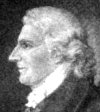 |
|
Norrkoping to a father who was a wealthy manufacturer. He went to school in Norrkoping with a private tutor and then studied under Carl Linnaeus the Younger and Carl Peter Thunberg at the University of Uppsala with studies in medicine and natural history, receiving a doctorate degree in 1781. The younger Linnaeus had held the chair of botany until 1784 when he was succeeded by Thunberg who had returned from South Africa and Japan in 1779 and became Swartz’s primary mentor and his lifelong friend. The subject of Swartz’s medical dissertation was mosses and lichens. |
Swartz found a new species of liverwort near Uppsala which was described by Linnaeus f. as Jungermannia sertularoides. In 1780 he traveled to Lapland with several other botanistical students along a path trodden by Linnaeus Senior and Olof Rudbeck. Swartz found some novelties for Lapland such as the orchids Chamorchis alpina and Leucorchis albida, and even a species new to science, Minuartia stricta. They returned to Uppsala via Finland and the island of Aland, which he returned to in 1781, discovering Polygala amarella as new to Scandinavia, as well as the new species Gentianapulchella, currently known as Centaurium pulchellum. He also traveled to Gotland, the largest island in the Baltic. In 1783 he sailed for North America and the West Indies, Jamaica, Hispaniola, and Cuba, to collect botanical specimens, and remained until 1786. He found hundreds of new species of plants, phanerogams as well as cryptogams, during his extensive explorations all over the island of Jamaica, The majority of his botanical collections were safely sent to Sweden, and he stopped off in London on the way home, remaining for more than half a year. He found Sir Joseph Banks to be both benevolent and friendly and worked on his collections. Banks was impressed by Swartz and offered him a position as ‘Travelling Physician’ in the British East India Company, which Swartz being homesick declined. He worked on a West Indian flora, and soon after his return to Sweden the Prodromus Florae Indiae Occidentalis was published in which 61 genera and 955 species were treated, many of them new to science. A more comprehensive Flora Indiae Occidentalis followed which was finally printed in Germany in three volumes (1797, 1800, 1806). The work covered the West Indian plants described by Linnaeus and Jacquin, altogether more than 1,000 species, and many of them authored by Swartz himself. Swartz was a talented artist and made drawings and water-colors of many plants including about 200 from the Caribbean. Swartz was the first specialist of orchid taxonomy, and published a critical review of orchid literature, classifying the 25 genera that he recognized through his own work. Although he is largely known for his pioneering work on flowering plants (especially orchids) and ferns, Swartz made important contributions to late eighteenth- and early nineteenth-century lichenology, publishing five major accounts describing 37 new species. Of these, 27 names are basionyms of accepted taxa. Swartz was a key supporter of Erik Acharius's work on the development of a new system of lichen taxonomy between 1794 and 1814, and Acharius critically examined his lichen collections from Sweden, the eastern United States and Jamaica. In 1789 he became a member of the Royal Swedish Academy of Sciences. In 1791 he became Professor Bergianus at the Academy of Sciences at Stockholm. He was elected a foreign honorary member of the American Academy of Arts and Sciences in 1805. He was appointed by the King as curator of the royal natural history collections, a position more prestigious than lucrative. In 1811 Swartz was appointed to the prestigious position as secretary of the Academy of Sciences which bought his library and herbarium after his death. He was married in 1794 but his wife died within a few years, leaving him with a son and a daughter. At the age of 57 years Swartz contracted a cold during an autumn walk in Stockholm. The illness developed to a severe 'nervous fever' from which he died on 19 September 1818. His botanical collection, of an impressive 6,000 specimens, is now held by the Swedish Museum of Natural History, as part of the Regnellian herbarium. Much of this information was extracted from an article by Bertil Nordenstam entitled “Olof Swartz, A 250-Year Anniversary,” produced for the International Seminar on "Multidisciplinary Approaches in Angiosperm Systematics."
- sweet'ii: named for Nathan Clark Sweet, Jr. (1919-2008). He was born in Pasadena, California, and died at the age of 89 in Atascadero. Mosses were his specialty and he was the author of The Moss Flora of Southern California published in 1943, which was his thesis at the Claremont Colleges. He was the discoverer of the type specimen of Trichostomum sweetii while accompanying Philip A. Munz on a vascular plant collecting trip.
- Swer'tia: named for Emanuel Sweerts (1552-1612) (sometimes spelled as Swert or Sweerts), a Dutch florist, botanist, artist and author of the Florilegium Amplissimum et Selectissimum, or Flowering Plants (1612). Wikipedia says: “Sweert was born at Zevenbergen and lived in a period when new plants from across the world were being introduced to Europe via Dutch, English and French ships. To meet the burgeoning interest in plants by the public, nurseries were being established by wealthy merchants in order to meet the demand. Botanical illustration suddenly found a new outlet in the production of nursery catalogues. Sweert prepared his Florilegium as a guide of his available stock for the Frankfurt Fair of 1612. The plates, depicting some 560 bulbs and flowers, were from the Johann Theodore de Bry Florilegium which in turn was based on that by Pierre Vallet. His attractively depicted bulbs sparked their popularity, leading to six editions of the work between 1612 and 1647, and a demand which would later result in "Tulipomania." At the time of the fair Sweert was in the employ of Emperor Rudolf II as head of his gardens in Vienna. He borrowed freely from plates that had been published before, so that many of those that appeared in the Florilegium had been cultivated in the gardens of King Henry IV of France at the Louvre.” He died at Amsterdam. The genus Swertia was published by Carlo Allioni in 1785.
- Syag'rus: from the Latin name syagrus used by Pliny for a
kind of palm-tree. The genus Syagrus was published by Carl Friedrich Philipp von Martius in 1824.
- sylvat'ica: of or growing in woods, forest-loving, sylvan, wild, from Latin sylvaticus, "of the forest."
- sylves'tris: growing in woods, forest-loving, wild, from Latin silvestris, literally "of a wood, of a forest, woody, rural, pastoral," from silva "wood, forest."
- sylvico'la: from Latin sylvaticus, "of the forest." and -cola, a suffix signifying "an inhabitant of or dweller in."
- Symphoricar'pos: from the Greek symphorein,
"borne together," and karpos, "fruit,"
and so meaning "fruit borne together" because of the clustered
berries. The genus Symphoricarpos was published by Henri Louis Duhamel du Monceau in 1755.
- Symphyotri'chum: from the Greek symphysis, for "borne
together or growing together, coalescing," and trichos or trichinos, "hair, a single hair," and according to FNA "perhaps alluding to a perceived basal connation of bristles in the European cultivar used by Nees as the type." The genus Symphyotrichum was published by Christian Gottfried Daniel Nees von Esenbeck in 1832.
- Symphy'tum: from the Greek sympho or symphein, "to
grow together," and phyton, "plant," together
being a name symphyton used by Dioscorides for the plant called
comfrey which was reputed to heal wounds. The genus Symphytum was published by Carl Linnaeus in 1753.
- Syntrichopap'pus: from the the Greek syn, "together," thrix, "hair,"
and pappos, "pappus," from the fused pappus bristles. The genus Syntrichopappus was published by Asa Gray in 1857.
- syntro'phus: the roots of this specific epithet would appear to be
the Greek syn, "together," and trophos, perhaps
"one who is fed, well-fed or well-nourished." One website
gave the derivation as from the Greek syntrophos, "foster
brother, one reared in the same house" but that was for the prokaryotic
genus Syntrophus and may not apply here. David Hollombe sent
this: "thriving together, which relates to the plants' clustered
growth habit, edaphic soil preference, stable morphology and allopatric
distribution."
- Synth'yris: from the Greek syn, "together," and thyris, "a small door," referring to the fruit valves. The genus Synthyris was published by George Bentham in 1846.
- syria'cum: Syrian.
- Systenothe'ca: from the Greek systenos, "narrow, tapering
to a point" and theke, "a box or case," alluding
to the shape of the involucre teeth. The genus Systenotheca was published by James Lauritz Reveal and Clare Butterworth Hardham in 1989.
- sys'tyla: David Hollombe sent me the following information: "Originally
described as a species of Nama, in which 'The connate styles,
united for more than two thirds their length, are peculiar to this
species' [Stylis longe ultra medium connatis inferne...].
(from Asa Gray, in Proceedings of the American Academy of Arts and Sciences)."
- syzigach'ne: derived from the Greek syzygos,
"a joining or yoking together," and achne, "anything
shaved off, froth, foam, down, chaff," from the glumes which tend to stick together by their tips.
- Syzyg'ium: from the Greek syzygos, "coupled, joined,
united." The genus Syzygium was published by Patrick Browne in 1788.
|

